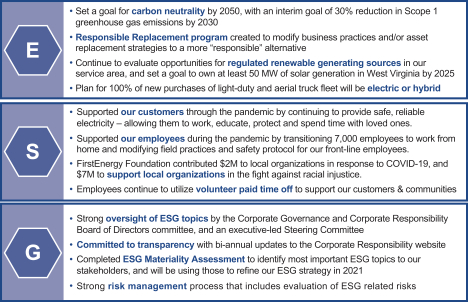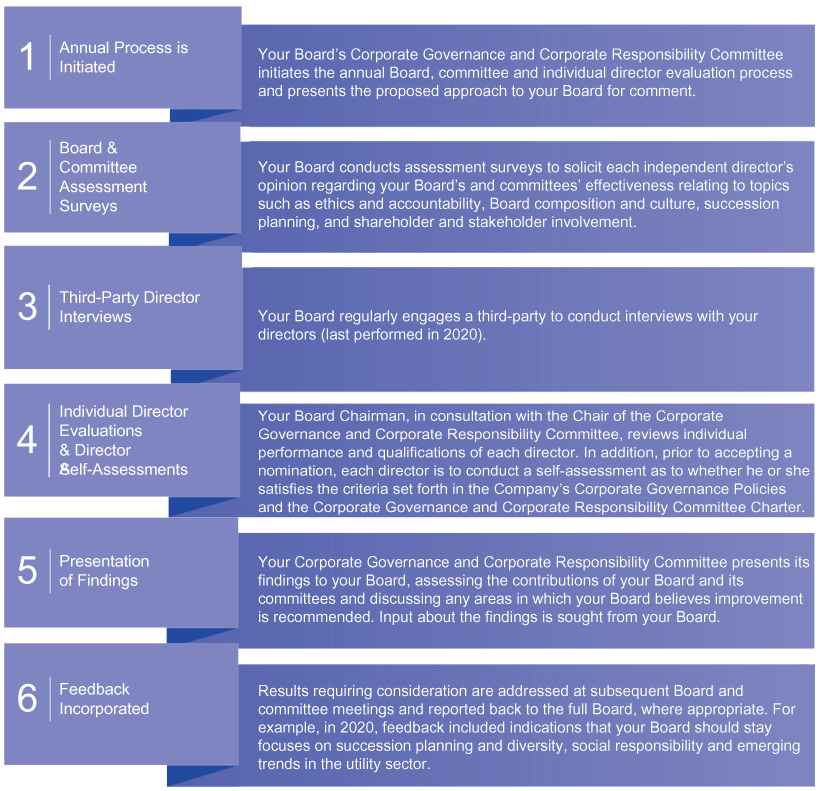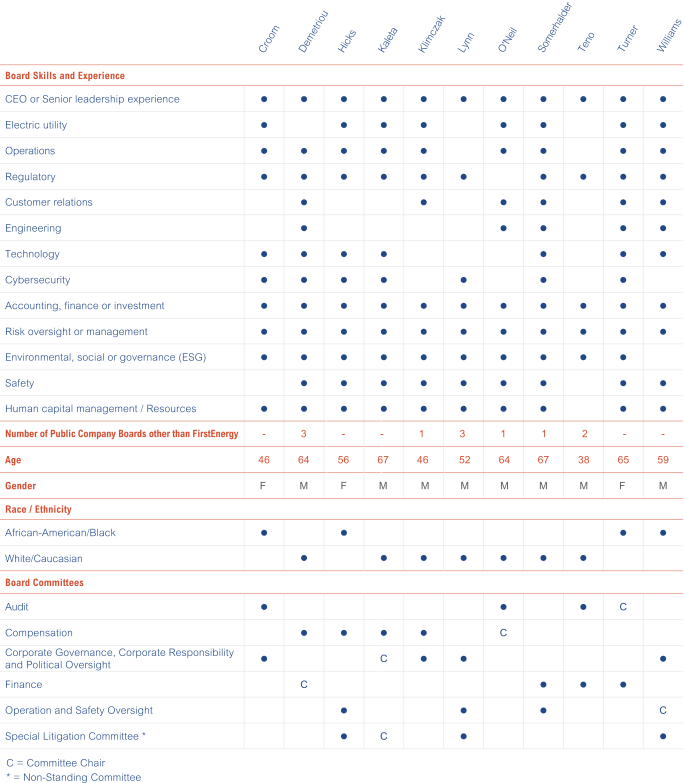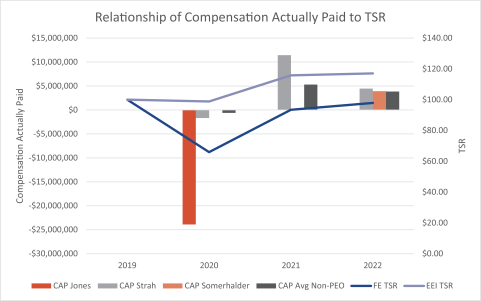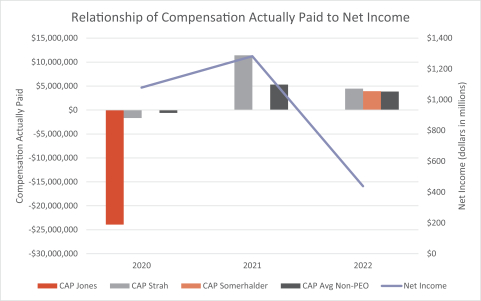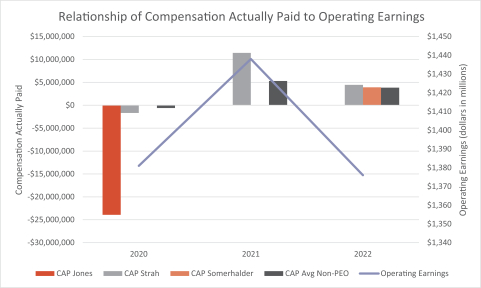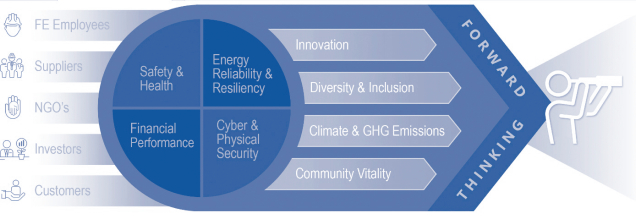Filed by the Registrant ☒ Filed by a Party other than the Registrant ☐ Check the appropriate box: ☐ Preliminary Proxy Statement ☐ ☒ Definitive Proxy Statement ☐ Definitive Additional Materials ☐ Soliciting Material Pursuant to §240.14a-12 Payment of Filing Fee (Check ☒ No fee required. ☐ Fee paid previously with preliminary materials: the appropriate box)all boxes that apply): ☐ Fee computed on table belowin exhibit required by Item 25(b) per Exchange Act Rules 14a-6(i)(1) and 0-11.
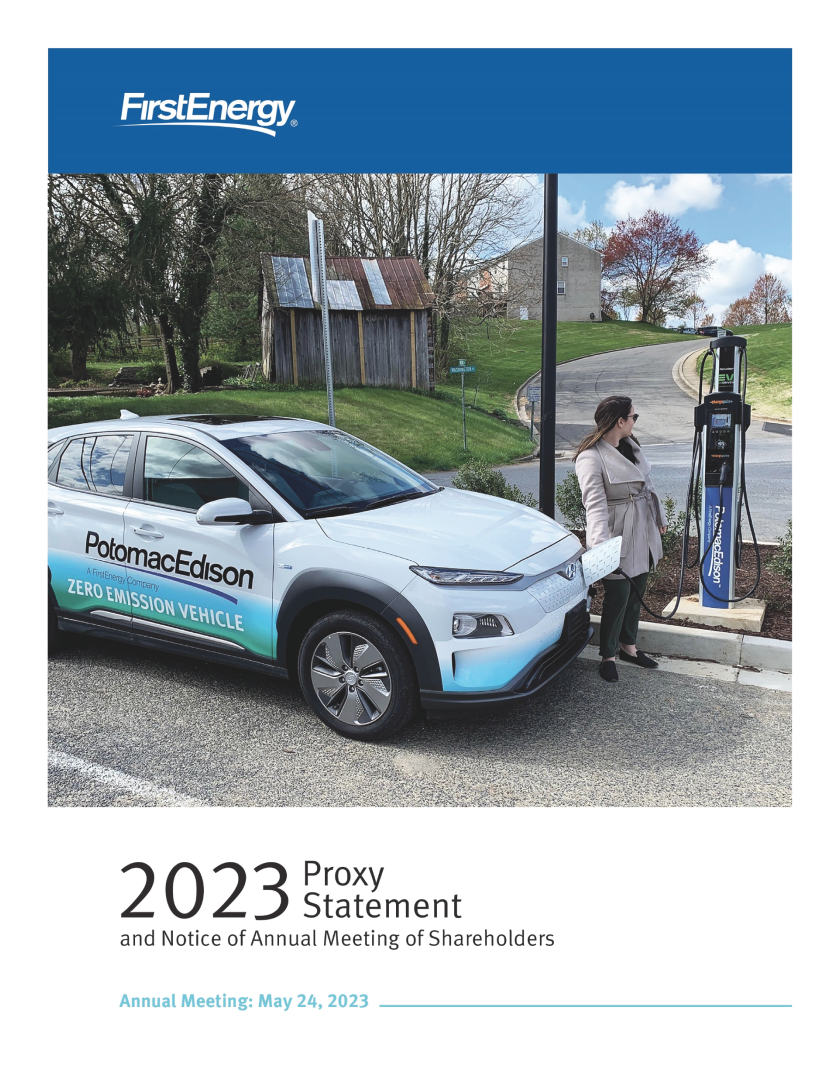
On the Cover: The Potomac Edison Company’s (a subsidiary of FirstEnergy Corp.) EV Driven program is a five-year initiative designed to benefit the state’s environment by reducing auto emissions and supporting Maryland’s goal to reach 300,000 zero-emission vehicles on the road by 2025. Potomac Edison is installing 59 charging stations – including 20 fast-charging stations – across its seven-county Maryland territory over the course of the program, which runs through 2023.
| ||||
March 28, 2023
| ||||||||
|
| |||||||
|
| |||||||
|
| |||||||
| ||||||||
|
| |||||||
|
| |||||||
|
| |||||||
|
| |||||||
|
| |||||||
|
| |||||||
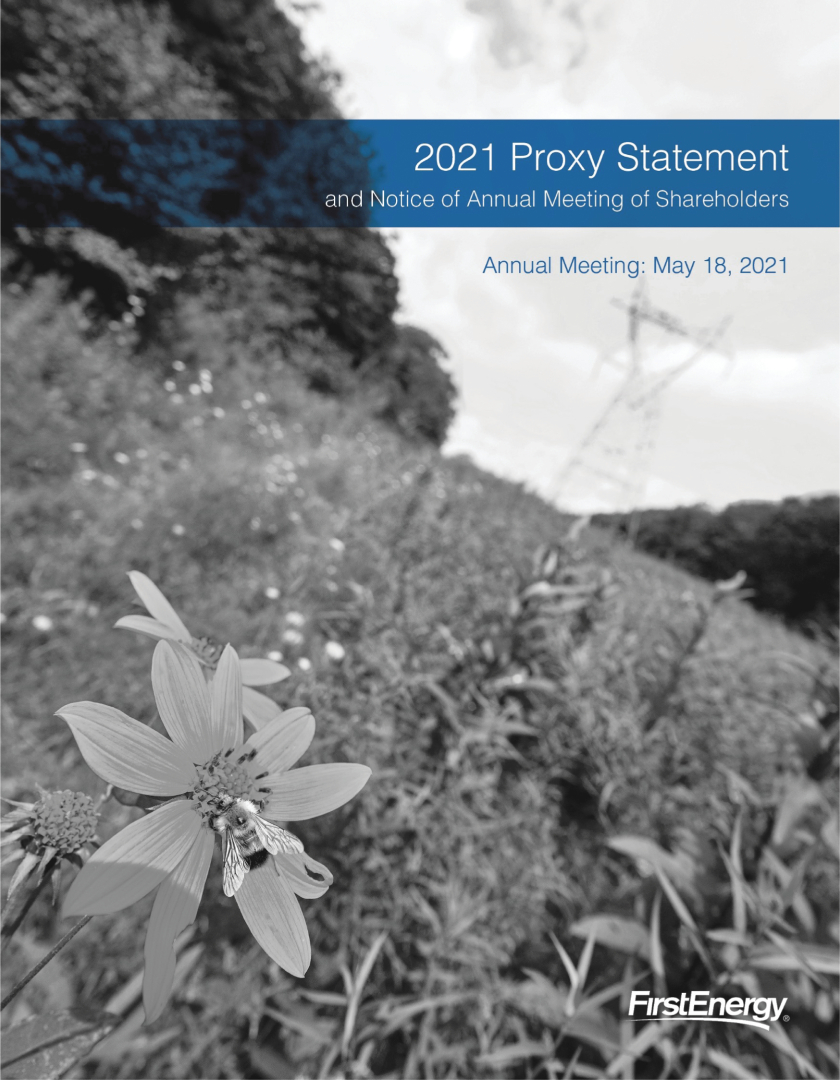
On the Cover: As part of our commitment to making the environment better, we’re promoting biodiverse, pollinator-friendly habitats in the transmission rights-of-way across our service area.
Location: Centre County, Pennsylvania (service territory of Penelec, an electric utility operating subsidiary of FirstEnergy)
Our Vegetation Management group participates in ongoing collaborative research with The Pennsylvania State University to monitor plants and pollinators in our transmission corridors. This and other similar research projects help FirstEnergy develop best practices for creating sustainable habitats in our rights-of-way, while also supporting the safe and reliable delivery of electricity to our customers.
|
|
|
John W. Somerhalder, II Chair of the Board and Interim President & CEO | ||||||
Dear FirstEnergy Shareholders:
Thank you for your continued confidence in FirstEnergy. On behalf of your Board of Directors and management I cordially invite you to attendteam, we welcome your attendance at our 20212023 Annual Meeting of Shareholders on May 18, 2021. The attached Notice24, 2023. A schedule of the 2021 Annual Meeting of Shareholders and Proxy Statement contain information about the business to be conducted at the Meeting.
Taking Decisive Actions to Position FirstEnergy for Long-Term Success. Let me begin by underscoring that staying true to our Core Values and Behaviors – and acting at all times and at all levelsmeeting is available in the attached Notice of the Company with2023 Annual Meeting of Shareholders, and the highest ethical standards – remains ataccompanying Proxy Statement includes information about your Board, FirstEnergy’s employee, environmental, social and governance (EESG) practices and our executive compensation programs.
The meeting will be conducted online. To attend the heartvirtual event, please follow the registration instructions listed on your proxy card. Additional registration information is available in the Questions and Answers section of who we seekthe accompanying Proxy Statement, under the heading, “Attending the Virtual Annual Meeting.”
Becoming a Premier Utility
I’m proud of FirstEnergy’s progress to bebecome a premier, forward-thinking electric company that is well positioned to deliver value to stakeholders. We’re harnessing our strengths while enhancing nearly every aspect of the organization, emerging as a companymore resilient, innovative and starts at the top. As summarized on pages 1-3 of this proxy statement, your Board has taken decisive actions, including announcing significant leadership changes as a result of a Board-led, independent, thorough and robust internal investigation related to the ongoing government investigations beginning last July. Your Board and executive management team are working diligentlyefficient company.
Recent highlights include executing transformative equity investments to enhance our corporate compliance programfinancial position and fuel our growth; modernizing our work practices and processes to fosteroptimize our performance, drive efficiencies and deliver a superior customer experience; and continued progress
fostering a culture rooted in our core values and focused on ethics, integrity and accountability.
Our newly named president and chief executive officer, Brian Tierney, will continue this important work when he joins the company June 1.
Brian is a deeply experienced and respected executive in our industry with a strong track record of proven results during his 28-year career, which includes leadership positions at Blackstone and American Electric Power.
He believes strongly in the steps we’ve taken to position FirstEnergy for stability and success. I am confident he is the right leader to build on our momentum and advance our long-term business strategy focused on strengthening our foundation, building a customer-centered focus and enabling the clean energy transition. We are excited to welcome him to the team. In addition to his role as president and CEO, we also expect to appoint him to the Board prior to his June 1 start date.
Expanding our corporate responsibility focus
Our strategy supports — and is supported by — our approach to corporate responsibility. Last year, we enhanced our corporate responsibility framework to include employee along with environmental, social and governance priorities. Recognizing employees as a distinct and essential pillar of our corporate responsibility approach pays tribute to their role in our success, as well as our commitment to cultivating a rewarding work environment where they can thrive.
| FIRSTENERGY CORP. | ||||
|
To learn more about our EESG priorities and how they’re making us a more innovative, diverse, sustainable and industry-leading company, I encourage you to review the “Commitments to EESG” section of the accompanying Proxy Statement as well as our refreshed corporate responsibility website at www.fecorporateresponsibility.com.
The website also includes an updated Climate Report aligned with guidance from the Task Force on Climate-related Financial Disclosures. The new report demonstrates FirstEnergy’s continued commitment to addressing the realities of climate change, while meeting stakeholder expectations for transparency and oversight.
Upholding high standards of governance
Strong corporate governance is foundational to our business and important to advancing the interests of our shareholders. Your highly independent and diverse Board oversees and guides FirstEnergy’s business strategy, including your Company’s progress building a strong, centralized compliance program, ensuring a culture of ethics and integrity and accountability at every level ofadvancing EESG matters.
We believe our shareholder engagement programs and investor communication efforts are vital to FirstEnergy’s success, and we value the organization and rebuild trustopportunity to further strengthen our engagement with our stakeholders. Atshareholders. With support from the same time,full Board, our executive management team and integrated shareholder outreach team — consisting of members of Corporate Responsibility, Corporate Secretary department, Legal, Finance, Human Resources and Investor Relations, hold regular conversations with a broad base of investors throughout the year. The feedback and suggestions gathered from these engagements guide the Board as we have remained focused on executing the Company’shelp FirstEnergy execute its business strategy and implementing initiatives to transform FirstEnergy in a way that provides near-term value while opening new opportunities for longer-term growth. We believe that these actions, together with the strength of the Company’s strategy, mission and 12,000 employees, will position FirstEnergy for long-term success.
A Resilient and Committed Team. On behalf of your Board, I want to express our gratitude to the employees across FirstEnergy who help make our communities stronger while delivering results for the business. In 2020, the FirstEnergy team came together to work smarter, more creatively and more efficiently. These efforts resulted in solid underlying performance in 2020, even in the context of the disruption and uncertainty caused by the COVID-19 pandemic.
A New Chief Executive Officer with Significant Operational Experience and a Deep Knowledge of the Business. Steven E. Strah, our new CEO of FirstEnergy, is a highly respected executive with a deep understanding of FirstEnergy’s business and significant operational experience, having served in various leadership roles at the Company during his 36-year career. He was appointed President in May 2020 and acting CEO in October 2020. Over the past several months, he has taken meaningful steps to put FirstEnergy on the right path forward, including ensuring a renewed emphasis on compliance and transparency throughout the organization; laying out his strategy, through FE Forward, to transform the Company; and working to reduce regulatory uncertainty affecting the Company’s Ohio utilities. Your Board is confident that his appointment to CEO and a member of the Board in March 2021 was the right step for FirstEnergy.
As CEO, your Board believes Steve will position FirstEnergy to move forward with positive momentum and execute FirstEnergy’s strategic priorities for the benefit of all stakeholders and drive enhanced value for shareholders. We look forward to continuing to work alongside Steve and the rest of the management team to build on the Company’s strong performance.
A Strong Highly Independent Board with the Right Skillset and Enhanced Oversight to Drive Value for Shareholders. Your Board is comprised of highly-qualified individuals who have a diverse set of skills, experiences, backgrounds and perspectives. We have periodically refreshed our Board with new Board members whom we believe bring new ideas and fresh perspectives into the boardroom – nine of the fourteen nominees will be new Board members added since 2016 (including our new director nominee – Melvin Williams). We have also entered into an agreement with Carl C. Icahn to appoint Andrew Teno and Jesse A. Lynn – both of whom are employees of Icahn entities – to your Board as independent directors. We are pleased to have reached this agreement with Mr. Icahn and we welcome the insights and experiences Mr. Teno and Mr. Lynn bring to your Board.
Your Board has also enhancedfulfill its oversight, including the formation of a Compliance Oversight Sub-Committee of the Audit Committee – comprised entirely of independent directors – tasked with overseeing the assessment of the Company’s corporate compliance program and governance practices. This sub-committee, supported by independent counsel and compliance advisors, assists in making recommendations, and overseeing the implementation of and enhancements to the Company’s corporate compliance program, structure and governance
practices, with the goal of building a best-in-class culture of compliance. Additionally, your Board has appointed John Somerhalder, a 40-year energy industry executive, as Vice Chairperson to help lead efforts to rebuild trust with FirstEnergy’s external stakeholders. He also joined the management team as Executive Director in a transitional capacity to support efforts to achieve FirstEnergy’s priorities and strengthen the Company’s governance and compliance functions. Your Board is focused on holding management accountable for implementing our strategy consistent with our risk management framework and fulfilling our regulatory obligations. For more information relating to your Board’s enhanced oversight, please refer to the “Board Oversight – Board Response to Government Investigations” section on page 1.
Our Bright Future. Your Board and management team are deeply committed to creating value for you. We are continuing to work quickly, decisively and with a strong sense of urgency to address current challenges and execute key initiatives to enhance shareholder value and reshape FirstEnergy into a more resilient, industry-leading organization of the future.
We remain focused on our mission to be a forward-thinking electric utility powered by a diverse team of employees committed to makingmake customers’ lives brighter, the environment better and our communities stronger. As part
We are focused on creating a more diverse, equitable and inclusive company, including at the senior leadership and Board levels. Our Board nominees demonstrate diversity in the form of that mission, we have introduced an ambitious new carbon neutrality goalgender, ethnicity, age, tenure, thought, background and comprehensive climate strategy that are fully aligned with our regulated business strategyexperience and support our goal of maintaining at least 30% diverse members by race, ethnicity and gender for the foreseeable future.
We also believe it is important to periodically refresh our Board with new members who bring fresh perspectives to the boardroom. Eight of our 11 director nominees have joined the Board since 2021.
Lighting the Way
It’s an exciting time for FirstEnergy, as we’re poised to leverage our many strengths: from our diverse assets, to the transformation that has taken place since 2020, to the talented employees who are making the company stronger with their drive, passion and ingenuity.
Together with these engaged and motivated employees, your Board and management team are deeply committed to serving our customers, meeting our commitments to stakeholders and strengthening our customers, communitiescompany for the future.
Your Board and investors, as well as environmental stewardship.
As always, wemanagement team will continue to engage with you regularly toand keep you updated on ouryour Company’s progress. We encourageI invite you to read more about your Board, our environmental, socialcompany strategies and governanceEESG practices, and our executive compensation programs in the accompanying proxy statement. We’re grateful forProxy Statement.
We appreciate your support and thank you in advance for voting promptly.
| Sincerely, | ||
 |
|
| 2023 PROXY STATEMENT |
Notice of Annual Meeting of Shareholders |
Notice of Annual Meeting of Shareholders
Please carefully review this Notice, the Company’s Annual Report to Shareholders for the year ended December 31, 20202022 (the “2020“2022 Annual Report”), and the accompanying proxy statementProxy Statement and vote your shares by following the instructions on your proxy card/voting instruction form or Notice of Internet Availability of Proxy Materials to ensure your representationvote is cast at the 2023 Annual Meeting.Meeting of Shareholders (the “Annual Meeting”).
| Wednesday, May 8:00 a.m. EDT | |
RECORD DATE March 27, 2023 |
The Annual Meeting will be a virtual meeting of shareholders, conducted via live webcast, and will take place at: www.cesonlineservices.com/
| |
|
| |
|
” Only shareholders of record as of the close of business on March | |
AGENDA
On behalf of the Board of Directors,
This Notice and accompanying Proxy Statement are being mailed or made available to shareholders on or about March
OUR VALUES
CODE OF CONDUCT FirstEnergy’s Code of Conduct, The Power of Integrity, lays the foundation for what we expect from the Board and all employees. It reflects our collective commitment to keep integrity at the forefront of everything we do — a pledge underscored by the inclusion of integrity in our mission, core values and company strategy. COMPANY STRATEGY FirstEnergy is embracing pivotal changes within our operations and culture that are energizing the company as we further our transformation into a forward-thinking, premium utility. Three pillars of strategy represent the focus of our efforts and investments and are backed by tangible goals.
EESG FOCUS The pillars of our company strategy are supported by our employee, environmental, social and governance (EESG) priorities and aligned with our commitment to corporate responsibility. Because of this strategic integration, improving our EESG performance also advances our strategy and helps us become a more innovative, diverse, sustainable and industry-leading company.
COMPANY CULTURE Transforming our company culture is foundational to achieving our company’s strategy. Our core values are the foundation of our transformation, our strategy and ultimately FirstEnergy’s long-term success. Integrity, Safety, Diversity, Equity and Inclusion (DEI), Performance Excellence, and Stewardship are the bedrock from which we operate, behave and interact every day. We are committed to a strong cultural foundation of ethics and integrity where employees feel safe to be themselves, speak up and bring their best to work every day. Creating a work environment that allows for greater diversity, equity and inclusion and prioritizes employees’ safety, health and well-being is also key to that cultural transformation. As part of our transformation we strive to prioritize, operationalize and live these values in everything we do, internally and externally. They guide our behavior, our decisions and ultimately the actions that create our performance and success. HUMAN CAPITAL MANAGEMENT FirstEnergy’s workforce is essential in our ability to continue moving our company forward by keeping each other safe, delivering value to our stakeholders, and transforming our culture in alignment with our core values. While 2022 continued to present unprecedented challenges, our commitment to our employees and their health and safety has not wavered. Integrity is critical to our path to a stronger, more sustainable FirstEnergy, and reflects our collective commitment to ensuring that we conduct business ethically. We expect all employees do the right thing, and we treat our coworkers and communities with the respect we all deserve. Further details of our focus on keeping our core values and behaviors at the center of everything we do, and our desire to help our employees to do their best each day is included in the “Our Commitment to EESG” section of this Proxy Statement.
CLIMATE STRATEGY Enabling the Energy Transition Our commitment to climate is a significant component of our company’s overarching strategy, especially our desire to enable the transition to a clean energy future. Executing our Climate Strategy and advancing the transition to clean energy requires addressing, among other things: emerging federal and state decarbonization goals; physical risks of climate change; industry trends and technology advancements; and customer expectations for cleaner energy, increased usage control, and more sustainable alternatives in transportation, manufacturing and industrial processes. Through our investment plan, we aim to enhance the resiliency, reliability and security of the electric system and support the integration of renewables, electric vehicles, grid modernization improvements and other emerging technologies. Reducing Greenhouse Gas Emissions As part of our Climate Strategy, we are also committed to reducing greenhouse gas (GHG) emissions. We’ve pledged to achieve carbon neutrality by 2050, with an interim 30% reduction in greenhouse gases within our direct operational control (Scope 1) by 2030 based on 2019 levels. This Scope 1 GHG goal encompasses companywide emissions across our transmission, distribution and regulated generation operations.
Key steps in working toward carbon neutrality by 2050 include:
To read more about our decarbonization strategy, including near-term actions to achieve our interim 30% GHG reduction target by 2030, please visit our Climate Report (www.firstenergycorp.com/climatereport). Information on our website does not constitute part of (and shall not be deemed incorporated by reference into) this Proxy Statement or any other document we file with the Securities and Exchange Commission (the “SEC”).
Proxy Statement Summary 2023 Annual Meeting of Shareholders (the “Annual Meeting” or the “Meeting”)
Your vote is important! Even if you plan to attend our Annual Meeting virtually, please cast your vote as soon as possible by:
Please follow the instructions provided on your proxy card/voting instruction form (the “proxy card”), Notice of Internet Availability of Proxy Materials, or electronic or other communications included with your proxy materials. Shareholders as of the March You may have multiple accounts and therefore receive more than one proxy card or voting instruction form and related materials. Please vote each proxy card and voting instruction form that you receive.
Your Board Nominees The following Your Board nominees are highly qualified individuals and represent a diversity of gender, ethnicity, age, tenure, thought, background and experiences. Your Board is
Key Board Corporate Governance Features Your
Our corporate governance practices are described in greater detail in the “Corporate Governance and Board of Directors Information” section beginning on page
Executive Compensation Highlights Under our compensation design, the percentage of pay that is based on performance increases as the responsibilities of a Named Executive Officer (“NEO”) increase. The charts below illustrate the mix of annual base salary rate
We believe
(1) Excludes Mr. Somerhalder due to the interim status of his roles. For more details see the “Performance-based and Time-based Equity Award for Mr. Somerhalder” section. Our executive compensation practices are described in greater detail in the “Executive Compensation” section beginning on page
Corporate Governance and Board of Directors Information Board Leadership Structure The Lead Independent Director Responsibilities Your Board recognizes the importance of independent oversight over management and
In May 2022, your Board, based on a recommendation from the Corporate Governance, Corporate Responsibility and Political Oversight Committee, elected Mr. Somerhalder and Ms. Hicks as its respective Board Chair and Lead Independent Director, each to serve until the first regular Board meeting following the Company’s 2023 annual meeting of shareholders. In September 2022, following the retirement of Mr. Steven Your Board alternate Board leadership structure is appropriate if changing circumstances dictate. Your Board schedules regular executive sessions for your independent directors to meet without management participation. Because an independent director is required to preside over each such executive session of independent directors, we believe it is efficient and appropriate to have your independent Board Composition and Refreshment Your Board is comprised of individuals who are
discussed in the “Board Qualifications” section of this The Corporate Governance, The Corporate Governance, Corporate Responsibility and Political Oversight Committee has sole authority to retain and engage a third-party search firm to identify a candidate or candidates for the Board. Board Oversight Board Response to Government Investigations Your Company has been cooperating fully with requests related to Your Board has formed various special Board oversight committees
Legal Proceedings Beginning in July 2020, stockholders of the Company filed shareholder derivative lawsuits in the federal courts for the Northern and Southern Districts of Ohio and in the Court of Common Pleas of Summit County, Ohio, asserting claims on behalf of the Company against various former and current officers and directors of the Company arising out of the circumstances at issue in the investigations and proceedings relating to Ohio House Bill 6. The lawsuits, Gendrich v. Anderson, et al. and Sloan v. Anderson, et al. (Common Pleas Court, Summit County, OH, all actions have been consolidated) and Miller v. Anderson, et al. (Federal District Court, N.D. Ohio); Bloom, et al. v. Anderson, et al.; Employees Retirement System of the City of St. Louis v. Jones, et al.; Electrical Workers Pension Fund, Local 103, I.B.E.W. v. Anderson et al.; Massachusetts Laborers Pension Fund v. Anderson et al.; The City of Philadelphia Board of Pensions and Retirement v. Anderson et al.; Atherton v. Dowling et al.; Behar v. Anderson, et al. (Federal District Court, S.D. Ohio, all actions have been consolidated), assert claims for breach of fiduciary duty and for violation of Section 14(a) of the Securities Exchange Act of 1934, (the “Exchange Act”), among other claims. As previously disclosed on March 11, 2022, the plaintiffs and defendants in the lawsuits, and the Special Litigation Committee acting on behalf of the Company, entered into a settlement agreement to resolve all of the shareholder derivative lawsuits. The settlement includes a series of corporate governance enhancements, that resulted in the following actions in connection with or following the Company’s 2022 annual meeting of shareholder (the “2022 Annual Meeting”):
The settlement also includes a payment to FirstEnergy of $180 million, to be paid by insurance, less the court-ordered attorney’s fees awarded to plaintiffs. On August 23, 2022, the Southern District of Ohio granted final approval of the parties’ Settlement Agreement, fully releasing all claims covered by the Settlement Stipulation, and dismissing the Southern District Action with prejudice. On September 20, 2022, a FirstEnergy shareholder filed a motion for reconsideration of the court’s Order of Final Settlement Approval. That motion is fully briefed and under consideration by the court. In addition, the Court of Common Pleas of Summit County, Ohio, dismissed the shareholder derivative lawsuit with prejudice, while the lawsuit filed in the Northern District of Ohio remains pending. While your Board cannot predict the outcome of the
Risk Management The Company recognizes that Your Board administers its risk oversight function through the full Board, as well as through the various Board
management the steps taken to monitor, control, and mitigate such exposures. In addition to the Audit Committee’s role in risk oversight, our other Board committees also play a role in risk oversight within each of their areas of responsibility. Specifically, the Compensation Committee reviews, discusses, and assesses risks related to
executive compensation programs, including incentive compensation and equity-based plans, as well as human capital and the relationship between our risk management policies and practices and compensation. See also, “Risk Assessment of Compensation Programs” found in the CD&A section in this Through this oversight process, your Board obtains an understanding of significant risk issues on a timely basis, including the risks inherent in the Company’s strategy. In addition, while the Company’s risk management group administratively reports to
Evaluating Board Effectiveness Your Board is committed to a rigorous evaluation process as further described below. Annually, Board, committee and individual director evaluations are performed and coordinated by the Corporate Governance, 2022 Board Evaluations: A Multi-Step Process
Shareholder Outreach and Engagement Program
In connection with our shareholder outreach In 2022 and early 2023, members of our Board
As part of our commitment to Other Governance Practices and Policies Code of Conduct FirstEnergy’s Code of Conduct, The Power of Integrity, lays the foundation for what we expect from all FirstEnergy employees, officers and directors, including our CEO, CFO, Chief Accounting Officer and other executives. It reflects our collective commitment to keep integrity at the forefront of everything we do — a pledge underscored by the inclusion of integrity in our mission and core values. By adhering to the expectations of compliance and ethics in this Code, always acting with uncompromising integrity, and speaking up when something doesn’t seem right, we are paving the way for a strong future for FirstEnergy. Any substantive amendments to, or waivers of, the provisions of this document will be disclosed and made available on our website, as permitted by the SEC and as disclosed in our most recent Annual Report. The Code is available, without charge, upon written request to the Corporate Secretary, FirstEnergy Corp., 76 South Main Street, Akron, Ohio 44308-1890 or is accessible on our website at www.firstenergycorp.com/responsibility. Corporate Governance Policies and Standing Committee Charters Your Board believes that the Company’s policies and practices should enhance your Board’s ability to represent your interests as shareholders. Your Board established Corporate Governance Policies which, together with Board committee charters, which are reviewed at least annually and serve as a framework for meeting your Board’s duties and responsibilities with respect to the governance of the Company. Our Corporate Governance Policies and Board committee charters can be viewed by visiting our website at www.firstenergycorp.com/charters. Any amendments to these documents will be made available on our website. Director Orientation and Continuing Education Your Board recognizes the importance of its members to keep current on Company, industry and governance issues and their responsibilities as directors. All new directors participate in orientation soon after being elected to your Board. Also, your Board makes available and encourages continuing education programs for Board members, which include internal strategy meetings and presentations and engagement with relevant third-party experts, third-party presentations and external programs.
Attendance at Board Meetings, Committee Meetings and the Annual Meeting of Shareholders Our Corporate Governance Policies provide that directors are expected to attend all scheduled Board and applicable committee meetings and the Company’s annual meetings of shareholders. Your Board held 18 meetings in 2022. The overall attendance percentage for our directors was approximately 96% in 2022, and all directors attended more than 75% of the Board meetings and the meetings of the committees upon which he or she served in 2022. Also, all of our directors who were members of the Board at the time of the 2022 Annual Meeting attended the 2022 Annual Meeting. Non-management directors met, as annually required, as a group in executive session without the CEO or any other non-independent director or member of management at each of the seven regularly scheduled 2022 Board meetings. Our Lead Independent Director presided over all executive sessions. Other Public Company Board Membership and Related Time Commitments Our Corporate Governance Policies provide that directors will not, without your Board’s approval, serve on a total of more than four public company board of directors (including FirstEnergy). Further, without your Board’s approval, no director who serves as an executive officer of any public company may serve on a total of more than two public company boards of directors, including FirstEnergy. Furthermore, when a director has a major change in their responsibilities, including principal employment or directorships, but excluding changes resulting from a normal retirement as well as commitments with non-profit organizations, the Corporate Governance, Corporate Responsibility and Political Oversight Committee considers such change and makes any appropriate recommendation to your Board. As further described in the “Biographical Information and Qualifications of Nominees for Election as Directors” section below, in addition to being a director of the Company, Mr. Demetriou recently stepped down as chief executive officer of Jacobs Solutions Inc. (formerly Jacobs Engineering Group Inc.) and, effective January 24, 2023, continues to serve as Executive Chair at Jacobs Solutions Inc. Mr. Demetriou also serves as a director of Arcosa, Inc. and as a director and non-executive board chair of C5 Acquisition Corp, a special acquisition company without significant operations. As described more fully on page 25, the Board has evaluated Mr. Demetriou’s current responsibilities and approved his current directorships, due in part to his significantly reduced future commitment expectations as well as the valuable experience and attributes he brings to your Board. Communications with your Board of Directors Your Board provides a process for shareholders and interested parties to send communications to your Board and non-management directors, including our The Corporate Secretary or a member of her staff reviews all such communications promptly and
has already Your Audit Committee also receives, reviews, and acts on complaints and concerns regarding accounting, internal accounting controls or auditing matters, including complaints regarding material ethical or criminal misconduct on the part of the Board of Directors, the Chief Executive Officer, any officer reporting directly to the Chief Executive Officer, the Controller & Chief Accounting Officer,
The Corporate Governance,
The Corporate Governance, Also refer to the “Proposals and Business by Shareholders” section of the “Questions and Answers about the Annual Meeting” below for information regarding nominations under the Company’s Second Amended and Restated Code of Regulations. Director Nomination On March 16, 2021, your Company entered into a Director Appointment and Nomination Agreement (the On November 6, 2021, your Company entered into a Common Stock Purchase Agreement (the “Blackstone SPA”) with BIP Securities II-B L.P., an affiliate of Blackstone Infrastructure Partners L.P. (“Blackstone”), for the private placement of 25,588,535 shares of the Company’s common stock. Pursuant to the Blackstone SPA, your Board, among other matters, agreed to appoint Mr. Sean T. Klimczak to stand for election as a director at the 2022 Annual Meeting. Shareholders elected Mr. Klimczak as a director at the 2022 Annual Meeting, and your Board has nominated him to stand for reelection as a director at the 2023 Annual Meeting to continue to serve for a term expiring at the 2024 Annual Meeting. Summaries of the terms of the Icahn Director Nomination Agreement
Attributes, Experience, Qualifications and Skills of your Board In recruiting and selecting Board candidates, the Corporate Governance,
The high-level overview below depicts some of the attributes, experiences, qualifications and skills of our director nominees the committee takes into account. It is not intended to be an exhaustive list of each director nominee’s skills or contributions to your Board. Also, additional biographical information and qualifications for each nominee is provided in the “Biographical Information and Qualifications of Nomineesfor Election as Directors” sectionbelow and contains information regarding the person’s service as a director, principal occupation, business experience along with key attributes, experience and skills. Each of the nominees brings a strong and unique background and skill set to your Board, giving your Board, as a whole, competence and experience in a wide variety of areas necessary to oversee the operations of the Company.
Board Nominees Skills, Diversity & Committee Memberships
The above takes into account a level of knowledge that could include direct experience, subject matter expertise, directly managing one or more members of management engaged in such activities or exposure as a board or board committee member, including on your Board and Board committees. Board’s Focus on Diversity The Company and your Board is committed to a policy of inclusiveness and believes that well assembled boards consist of a diverse group of individuals who possess a variety of complementary skills and experiences. Accordingly, your Board has set a goal that, for the foreseeable future, at least 30% of your Board will be composed of diverse (by gender, race and ethnicity combined) individuals. The Corporate Governance,
Director Independence Your Board annually reviews the independence of each of its members to make the affirmative determination of independence that is called for by our Corporate Governance Policies and required by the
Each year, our directors complete a questionnaire to assist your Board in assessing whether each director meets the applicable independence standards and the related provisions in the Company’s Corporate Governance Policies. The Company facilitates this review by examining its Your Board recognizes that in the ordinary course of business, relationships and transactions may occur between the Company and its subsidiaries and entities with which some of our directors are or have been affiliated. Our Corporate Governance Policies provide categorical standards to assist your Board in determining what does not constitute a material relationship for purposes of determining a director’s independence. Accordingly, the following commercial and charitable relationships will not be considered to be a material relationship that would impair a
organization, were less than the greater of $1 million or 2% of the affiliated company’s revenues in each of the last three fiscal years. Based on the
Company and none of the Company’s directors are related to any executive officer of the Company. The Corporate Governance,
Qualifications of Nominees for Election as Directors The following provides information about each director
POSITION, PRINCIPAL OCCUPATION AND BUSINESS EXPERIENCE: Mr. Demetriou serves as executive chair of the board of directors of Jacobs Solutions Inc. (“Jacobs”) (formerly Jacobs Engineering Group Inc.), a provider of technical professional services, including consulting, technical, scientific and project delivery for the government and private sector since January 2023. He previously served as chief executive officer of Jacobs (from 2015 to January 2023). In connection with Jacobs’ succession plan, he currently serves as executive chair of Jacobs’ Board. He also serves as a director (non-executive board chair) of two other public companies: Arcosa, Inc., a provider of infrastructure-related products and solutions since January 2023, and C5 Acquisition Corporation (“C5AC”), a special purpose acquisition company since January 2022, which at this time is not an active business with significant operations. He previously served as chairman and chief executive officer (from 2004 to 2015) of Aleris Corporation, a manufacturer of aluminum rolled products and as a director of Kraton Corporation (from 2009 to 2017). KEY ATTRIBUTES, EXPERIENCE AND SKILLS: Mr. Demetriou received his Bachelor of Science degree in chemical engineering from Tufts University. He has extensive experience in leadership and senior management roles, including the role of chief executive officer. In addition, he brings experience in a variety of industries, including engineering, construction and oil and gas. He also has substantial experience with a company that provides cybersecurity, sustainability and environmental related solutions. His extensive executive and board experience has equipped him with leadership skills and the knowledge of board processes and functions. This experience qualifies him to serve as a member of your Board. OTHER INFORMATION: In assessing whether directors and director nominees, including Mr. Demetriou, have sufficient time to devote to board duties and responsibilities, the Corporate Governance, Corporate Responsibility and Political Oversight Committee and your Board consider, among other things, the commitments of each director on the boards of other public companies. In recommending to the full Board the re-election of Mr. Demetriou, the members of the Corporate Governance, Corporate Responsibility and Political Oversight Committee considered the requirements of the Board’s Corporate Governance Policies, as well as the policies of several of the Company’s major shareholders regarding the number of board of directors upon which an executive chair should serve. In addition to your Board, Mr. Demetriou also serves on the boards of directors of Arcosa, Inc., C5AC, and, since January, 2023, serves as executive chair of Jacobs after stepping down as its chief executive officer as part of ordinary succession planning. Following robust due diligence regarding Mr. Demetriou’s commitments, including feedback from shareholders, your Corporate Governance, Corporate Responsibility and Political Oversight Committee and the Board believe that Mr. Demetriou has demonstrated, and will continue to demonstrate, the ability to dedicate sufficient time to carry out his Board duties effectively. They believe it is in the Company’s best interest that he continue to serve as a director for the following reasons:
The Board appreciates shareholders’ focus on director commitments. The Board will continue to regularly evaluate the roles and responsibilities of all directors and director nominees (including Mr. Demetriou) with respect to your Board to ensure that each director and director nominee continues to be able to dedicate the time necessary to fulfill such responsibilities.
POSITION, PRINCIPAL OCCUPATION AND BUSINESS EXPERIENCE: Lead Independent Director of the Board since May 2022. Retired board chair of MV Transportation, Inc., a privately owned passenger transportation contracting firm and provider of paratransit services (from 2014 to 2022). She served as executive vice president, general counsel and corporate secretary for MV Transportation (from 2012 until 2018). KEY ATTRIBUTES, EXPERIENCE AND SKILLS: Ms. Hicks received a Bachelor of Arts in Political Science from Stanford University and a Juris Doctorate from Harvard Law School. As executive vice president and general counsel of MV Transportation, Hicks directed all company legal affairs including its acquisition of businesses, defense and resolution of litigation, as well as corporate compliance and governance. From 2004 until 2008, Hicks was senior vice president and associate general counsel for TXU Corp., a Dallas based energy holding company. Following the acquisition of TXU Corp by private investors and its name change to Energy Future Holdings, Hicks became its corporate secretary and continued in the role of senior vice president and associate general counsel managing legal and board functions including corporate governance, compliance and security programs, employee benefits and executive compensation, litigation risk and strategy. Earlier in her career she worked as a litigator in private law practice and served in various roles at the U.S. Department of Justice and in the White House where she was Associate Counsel to the President. Ms. Hicks’ legal, regulatory, compliance and energy-sector experience qualifies her to serve as a member of your Board.
POSITION, PRINCIPAL OCCUPATION AND BUSINESS EXPERIENCE: Retired executive vice president, general counsel, federal affairs, chief compliance officer, and corporate secretary of First Solar, Inc., a global solar company (from 2014 to 2020). Managing director of SERC Consulting LLC, an energy policy and strategy firm, since 2020. Previously served as executive vice president, general counsel, shared services, chief compliance officer, and corporate secretary of NV Energy, Inc., an electric and gas utility (from 2006 to 2013). KEY ATTRIBUTES, EXPERIENCE AND SKILLS: Mr. Kaleta received his law degree from Georgetown University Law Center and his undergraduate degree from Hamilton College. He has more than 30 years of leadership and business experience as a senior executive and general counsel for companies across the energy industry, including both regulated utility and clean energy technology companies. He also has served on energy advisory, technology, and industry boards, was a partner in a Washington, D.C. law firm, and was an adjunct professor teaching energy law and business ethics. Mr. Kaleta’s varied and comprehensive utility, energy transition, renewable energy, governmental affairs, and corporate governance and compliance experience qualifies him to serve as a member of your Board.
POSITION, PRINCIPAL OCCUPATION AND BUSINESS EXPERIENCE: Senior managing director and global head of infrastructure at Blackstone Inc., a global investment firm, where Mr. Klimczak has been since 2005. Mr. Klimczak was previously a director of the following: Custom Truck One Source, L.P. (from 2015 to 2021), Cheniere Energy Inc. (from 2021 to 2022) and the general partner of Cheniere Energy Partners L.P. (from 2012 to 2017), as well as serving on the board of numerous other companies throughout his career. KEY ATTRIBUTES, EXPERIENCE AND SKILLS: Mr. Klimczak received a Bachelor of Business Administration in Finance and Business Economics from the University of Notre Dame and a Master of Business Administration from Harvard Business School. Prior to his position at Blackstone, Mr. Klimczak was an Associate at Madison Dearborn Partners. Prior to that, he worked in the Mergers & Acquisitions department of Morgan Stanley & Company’s Investment Banking Division. Mr. Klimczak’s energy infrastructure industry expertise and financial and investment experience qualifies him to serve as a member of your Board.
POSITION, PRINCIPAL OCCUPATION AND BUSINESS EXPERIENCE: General Counsel of Icahn Enterprises L.P., a diversified holding company engaged in a variety of businesses, including investment, energy, automotive, food packaging, real estate, home fashion and pharma, since 2014. Mr. Lynn also has served as chief operating officer of Icahn Capital LP, the entity through which Carl C. Icahn manages investment funds, since April 2021. Mr. Lynn also serves as a director of the following three other public companies: Conduent Incorporated, a provider of business process outsourcing services, since 2019; Crown Holdings, Inc., a supplier of packaging products, and equipment and related services, since December 2022 and Xerox Holdings Corporation, a provider of print and digital document products and services, since 2021. Mr. Lynn was previously a director of Cloudera, Inc., a provider of enterprise data cloud services, from 2019 through its sale in 2021; Herbalife Nutrition Ltd., a nutrition company (from 2014 to 2021); and The Manitowoc Company, Inc., a capital goods manufacturer (from 2015 to 2018). KEY ATTRIBUTES, EXPERIENCE AND SKILLS: Mr. Lynn received a Bachelor of Arts from the University of Michigan and a Juris Doctor from the Boston University School of Law. He has extensive experience in a variety of businesses, including investment, energy, automotive, food packaging, real estate, home fashion and pharma. Prior to his current position, Mr. Lynn was assistant general counsel of Icahn Enterprises L.P. (from 2004 to 2014). Prior to joining Icahn Enterprises L.P., Mr. Lynn worked as an associate in the New York office of Mintz, Levin, Cohn, Ferris, Glovsky and Popeo, P.C. in its business and finance department and as an associate in the corporate group at Gordon Altman Butowsky Weitzen Shalov & Wein. Mr. Lynn’s legal experience and his experience in a variety of industries along with his broad business skills make him a valuable member of your Board.
POSITION, PRINCIPAL OCCUPATION AND BUSINESS EXPERIENCE: Chief executive officer and vice chairman of Orbital Infrastructure Group, Inc. (formerly Orbital Energy Group, Inc.), a company focused on acquisition and development of innovative companies to create a diversified services platform, since 2019. Principal owner of Forefront Solutions, LLC, which provides consulting services primarily to the energy infrastructure industry, since 2017. Former president, chief executive officer and director of Quanta Services, Inc., a provider of specialty contracting services to the electric power and oil and gas industries (from 2011 to 2016). He served as a director of Hennessy Capital Acquisition Corp IV (from 2019 to 2020), NRC Group Holdings (from 2017 to 2019) and Spark Power Group Inc. (from 2018 to 2019). KEY ATTRIBUTES, EXPERIENCE AND SKILLS: Mr. O’Neil received his Bachelor of Science degree in civil engineering from Tulane University. He has extensive leadership and senior management experience, including the role of chief executive officer, chief operating officer and senior vice president of operations integration and audit. His experience in the electric utility industry also provides him substantial experience in sustainability and environmental related matters. His extensive executive and board experience have equipped him with leadership skills and the knowledge of board processes and functions. Additionally, Mr. O’Neil’s audit, general corporate decision-making and engineering experience makes him a valuable member to your Board.
POSITION, PRINCIPAL OCCUPATION AND BUSINESS EXPERIENCE: Interim President and Chief Executive Officer of your Company since September 2022. He has served as Chair of your Board since May 2022, and previously served as Vice Chair and Executive Director of your Company from March 2021 to May 2022. Mr. Somerhalder also recently served as interim president and chief executive officer of CenterPoint Energy, Inc., an electric and natural gas utility serving several U.S. markets (from February 2020 to July 2020) and served as a member of the CenterPoint Energy’s board of directors (from 2016 through 2020). He serves as a director of one other public company: KKR Infrastructure Conglomerate LLC, a company that operates as an investment vehicle. He also served as a director of Gulfport Energy Corp (from 2020 to 2021), as a director and board chairman of Enable Midstream Partners, LP (from February 2020 to July 2020), as a Director of SunCoke Energy Partners GP LLC (from 2017 to 2019), and as director at Crestwood Equity GP LLC, the general partner of Crestwood Equity Partners LP (from 2013 to 2020). KEY ATTRIBUTES, EXPERIENCE AND SKILLS: Mr. Somerhalder holds a Bachelor of Science degree in chemical engineering from the University of Arizona. He served as interim president and chief executive officer of Colonial Pipeline Company, a U.S. refined products pipeline company (from February 2017 to October 2017). Prior to that, he was president and chief executive officer of AGL Resources Inc., a former publicly traded energy services holding company (from 2006 to his retirement in 2015), and chairman of AGL Resources board of directors (from 2007 to 2015). Prior to joining AGL Resources, Mr. Somerhalder served in a number of roles with El Paso Corporation, a publicly traded natural gas and related energy products provider, where he spent almost 30 years, starting his career as an engineer and progressing through leadership roles before being named president of El Paso Pipeline Group and executive vice president of El Paso Corporation. He has extensive leadership and senior management experience, including the roles of chief executive officer and board chairman. His extensive energy industry, executive and board experience have equipped him with leadership skills and knowledge of the industry, and board processes and functions. Mr. Somerhalder’s extensive experience qualifies him to serve on your Board, lead efforts to rebuild trust with our external stakeholders, support our senior leadership team’s efforts to achieve its priorities, and strengthen your Company’s governance and compliance functions.
POSITION, PRINCIPAL OCCUPATION AND BUSINESS EXPERIENCE:
KEY ATTRIBUTES, EXPERIENCE AND SKILLS: Mr. Teno received an undergraduate business degree from the Wharton School at the University of Pennsylvania. Prior to his current position at Icahn Capital, Mr. Teno worked at Fir Tree Partners, a New York based private investment firm. Prior to Fir Tree, he worked at Crestview Partners as an associate in their private equity business and at Gleacher Partners, a boutique mergers and acquisitions firm. Mr. Teno’s investment expertise and experience in a variety of industries, along with his business skills, make him a valuable member of your Board.
POSITION, PRINCIPAL OCCUPATION AND BUSINESS EXPERIENCE: Retired in 2018 as senior vice president, general counsel and corporate secretary (positions held since 2012) of The Hershey Company, a global confectionery company. KEY ATTRIBUTES, EXPERIENCE AND SKILLS: Ms. Turner received her law degree from the Georgetown University Law Center after graduating from the New York University with a Bachelor of Science degree. She also received a Master of Laws in Law and Government from the American University, Washington College of Law. Ms. Turner has extensive and wide-ranging leadership, legal, governance and corporate strategy skills through her former roles with The Hershey Company and The Coca-Cola Company. Ms. Turner served as senior vice president, general counsel, and corporate secretary of The Hershey Company from 2012 until her retirement in March 2018. In this role, Ms. Turner was the leader of Hershey’s legal, government relations, corporate secretary, and corporate security functions. She also advised Hershey on M&A opportunities and other stakeholder considerations facing publicly traded companies. Prior to joining Hershey, Ms. Turner’s career included progressively more responsible leadership roles at Coca-Cola, Akin Gump Hauer & Feld, LLP and the senior executive service level of the federal government. Ms. Turner’s legal experience and additional regulatory experience qualify her to serve as a member of your Board.
Your Board
Your Board appoints at least one member of the Audit Committee who, in your Board’s business judgment, is an “Audit Committee Financial Expert,” as such term is defined by the SEC. Your Board determined that Ms. Croom and Messrs. Effective May 17, 2022, Ms. Turner was appointed Chair of the Audit Committee, and Ms. Croom and Mr.
Effective May 17, 2022, Ms. Hicks and Messrs. Kaleta and Klimczak were appointed to the Compensation Committee. | |||||||||||||||||||||||||||||||||||||||||||||||||||||||||||||||||||||||||||||||||||||||||||||||||||||||||||||||||||||||||||||||||||||||||||||||||||||||||||||||||||||||||||||||||||||||||||||||||||||||||||||||||||||||||||||||||||||||||||||||||||||||||||||||||||||||||||||||||||||||||||||||||||||||||||||||||||||||||||||||||||||||||||||||||||||||||||||||||||||||||||||||||||||||||||||||||||||||||||||||||||||||||||||||||||||||||||||||||||||||||||||||||||||||||||||||||||||||||||||||||||||||||||||||||||||||||||||||||||||||||||||||||||||||||||||||||||||||||||||||||||||||||||||||||||||||||||||||||||||||||||||||||||||||||||||||||||||||||||||||||||||||||||||||||||||||||||||||||||||||||||||||||||||||||||||||||||||||||||||||||||||||||||||||||||||||||||||||||||||||||||||||||||||||||||||||||||||||||||||||||||||||||||||||||||||||||||||||||||||||||||||||||||||||||||||||||||||||||||||||||||||||||||||||||||||||||||||||||||||||||||||||||||||||||||||||||||||||||||||||||||||||||||||||||||||||||||||||||||||||
Corporate Governance, | ||||||||
Melvin D. Williams
| The Corporate Governance,
◾ the
| |||||||
◾ oversight of the Company’s policies and practices relating to corporate responsibility. The Committee is also directly responsible for oversight of our (i) political activities and practices and (ii) our Company’s corporate citizenship practices Effective May 17, 2022, Mr. Kaleta was appointed to and as Chair of the Corporate Governance, Corporate Responsibility and Political Oversight Committee, and Ms. Croom and Mr. Klimczak were appointed to the Corporate Governance, Corporate Responsibility and Political Oversight Committee. | ||||||||
Mr. Lynn and Mr. Pappas were appointed to the Corporate Governance and Corporate Responsibility Committee effective March 23, 2021 and April 1, 2021, respectively.
20 | FirstEnergy Corp. 2021 Proxy Statement

| 2023 PROXY STATEMENT | 32 |
Proxy | Corporate | Items to Be | Commitments to EESG | Executive & Director Compensation | Other Important Matters / Q&A |
| Finance Committee | 6 meetings in fiscal year 2022 | |
John W. Somerhalder II Andrew Teno Leslie M. Turner
|
| |
| The Finance Committee is primarily responsible for monitoring and overseeing the Company’s financial resources and strategies, with emphasis on those issues that are long-term in nature. For a complete list of responsibilities and other information, refer to the Finance Committee Charter available on website at www.firstenergycorp.com/charters.
Effective May 17, 2022, Mr. | |
Operations and Safety | 5 meetings in fiscal year 2022 | |
Melvin D. Williams (Chair) Jesse A. Lynn John W. Somerhalder II Lisa Winston Hicks
|
| |
| The Operations and Safety Oversight Committee is primarily responsible for monitoring and overseeing the Company’s significant operating matters relating to the Company’s electric power generation and distribution and transmission Effective May 17, 2022, Mr. Williams was appointed as Chair of the Operations and Safety Oversight Committee, and Messrs. Lynn and Somerhalder and Ms. Hicks were appointed to the Operations and Safety Oversight Committee. | |
| 33 | FIRSTENERGY CORP. |
21 | FirstEnergy Corp. 2021 Proxy Statement

Proxy | Corporate | Items to Be | Commitments to EESG | Executive & Director Compensation | Other Important Matters / Q&A |
Special Board Oversight Committees | ||
Leslie M. Turner (Chair) Jana T. Croom Andrew Teno | Compliance Oversight
Committee. | |
Lisa Winston Hicks Jesse A. Lynn Melvin D. Williams | Special Litigation Committee is authorized to take all actions as it deems advisable, appropriate, and
| |
| 2023 PROXY STATEMENT | 34 |
|
| |||||||||
Items to Be | Commitments to EESG | Executive & Director Compensation | Other Important Matters / Q&A |
22 | FirstEnergy Corp. 2021 Proxy Statement

| Item 1 | Election of Directors
| |
✓Your Board recommends that you vote FOR |
You are being asked to vote for the following 1411 nominees (13 current directors and one new director nominee) to serve on your Board for a term expiring at the annual meeting of shareholders in 20222023 and until their successors shall have been elected: Michael J. Anderson, Jana T. Croom, Steven J. Demetriou, Julia L. Johnson,Lisa Winston Hicks, Paul Kaleta, Sean T. Klimczak, Jesse A. Lynn, Donald T. Misheff, Thomas N. Mitchell, James F. O’Neil III, Christopher D. Pappas, Luis A. Reyes, John W. Somerhalder II, Steven E. Strah, Andrew Teno, Leslie M. Turner and Melvin Williams. Messrs. Somerhalderand Strahwere elected to yourWilliams. On March 22, 2023, the Board effective March 1, 2021 and March 8, 2021, respectively, and are nominees for election by shareholders at the Annual Meeting. Messrs. Lynnand Tenowere appointed to your Board effective March 18, 2021, pursuantBrian X. Tierney to the Director Nomination Agreementposition of President and are nominees for election by shareholders at the Annual Meeting.Chief Executive Officer of FirstEnergy, effective as of June 1, 2023. Mr. Somerhalder will cease serving as Interim President and Mr. Williams were identified by a third-party search firm as potential candidates and recommended as directors by the members of our Corporate Governance and Corporate Responsibility Committee. In addition, Sandra Pianalto has not been nominated for re-election at the Annual Meeting, and her term on your Board will expireChief Executive Officer at the conclusion of the Annual Meeting.May 31, 2023, but will continue to serve as a non-employee director on your Board.
The “Biographical Information and Qualifications of Nominees for Election as Directors” section of this proxy statementProxy Statement provides information for all nominees for election at the Annual Meeting. The “Board Qualifications” section ofabove in this proxy statementProxy Statement provides information relating to your Board’s and Corporate Governance, and Corporate Responsibility and Political Oversight Committee’s review of nominees. Your Board has no reason to believe that the persons nominated will not be available to serve after being elected. If any of these nominees would not be available to serve for any reason, shares represented by the appointed proxies will be voted either for a lesser number of directors or for another person selected by your Board. However, if the inability to serve is believed to be temporary in nature, the shares represented by the appointed proxies will be voted for that person who, if elected, will serve when able to do so.
Pursuant to the Company’s Second Amended and Restated Code of Regulations, at any election of directors, a nominee shall be elected to your Board only if the vote “For” the candidate exceed the votes “Against” the nominee; abstentions and broker non-votes will have no effect. Our Corporate Governance Policies also provide that in an uncontested election of directors (i.e., an election where the only nominees are those recommended by your Board), any nominee for director who receives a greater number of votes “Against” his or her election than votes “For” his or her election will promptly tender his or her resignation to the Corporate Governance, and Corporate Responsibility and Political Oversight Committee following certification of the shareholder vote. The Corporate Governance, and Corporate Responsibility and Political Oversight Committee will promptly consider the tendered resignation and will recommend to your Board whether to accept or reject the tendered resignation no later than 60 days following the date of the shareholders’ meeting at which the election occurred. In considering whether to recommend acceptance or rejection of the tendered resignation, the Corporate Governance, and Corporate Responsibility and Political Oversight Committee will consider factors deemed relevant by the committee members, including the director’s length of service, the director’s particular qualifications and contributions to the Company, the reasons underlying the majority withheld vote, if known, and whether these reasons can be cured, and compliance with stock exchange listing standards and the Corporate Governance Policies. In considering the Corporate Governance, and Corporate Responsibility and Political Oversight Committee’s recommendation, your Board will consider the factors considered by the Corporate Governance, and Corporate Responsibility and Political Oversight Committee and any such additional information and factors your Board believes to be relevant. Your Board will act on the Corporate Governance, and Corporate Responsibility and Political Oversight Committee’s recommendation no later than at its next regularly scheduled Board meeting.
| Your Board Recommends That You Vote “For” All Nominees in Item 1. ✓ |
23 | FirstEnergy Corp. 2021 Proxy Statement

| 35 | FIRSTENERGY CORP. |
Proxy | Corporate | Items to Be | Commitments to EESG | Executive & Director Compensation | Other Important Matters / Q&A |
| Item 2 | Ratification of the Appointment of the Independent Registered Public Accounting Firm For
| |
✓Your Board recommends that you vote FOR Item |
You are being asked to ratify the Audit Committee’s appointment of PricewaterhouseCoopers LLP as the Company’s independent registered public accounting firm to examine the books and accounts of the Company for the fiscal year ending December 31, 2021.2023. While our Second Amended and Restated Code of Regulations does not require shareholders to ratify the appointment of PricewaterhouseCoopers LLP as our independent registered public accounting firm, we are submitting the proposal for ratification as a matter of good corporate governance. However, if shareholders do not ratify the appointment, the Audit Committee will reconsider retaining PricewaterhouseCoopers LLP.LLP in future years. Even if the appointment is ratified, the Audit Committee, at its discretion, may change the appointment at any time during the year if it determines that such a change would be in the best interests of the Company and its shareholders. A representative of PricewaterhouseCoopers LLP is expected to attend the Annual Meeting and will be available to respond to appropriate questions and have an opportunity to make a statement if he or she wishes to do so. We refer you to the “Matters Relating to the Independent Registered Public Accounting Firm” section of this proxy statementProxy Statement for information regarding services performed by, and fees paid to, PricewaterhouseCoopers LLP during the years 20192021 and 2020.2022. Item 2 requires the affirmative vote of a majority of the votes cast and abstentions will have no effect. There can be no broker non-votes on Item 2 as it is considered a “routine” matter under applicable NYSE rules.
| Your Board Recommends That You Vote “For” Item 2. ✓ |
24 | FirstEnergy Corp. 2021 Proxy Statement

| 36 |
Proxy | Corporate | Items to Be | Commitments to EESG | Executive & Director Compensation | Other Important Matters / Q&A |
| Item 3 | Approve, on an Advisory Basis, Named Executive Officer Compensation
| |
✓Your Board recommends that you vote FOR Item |
The following proposal provides shareholders the opportunity to cast an advisory, non-binding vote to approve the compensation of the NEOs (a “Say-on-Pay”“Say-on-Pay” vote) as further described in the CD&A and the related compensation tables and narrative disclosure. This resolution is required pursuant to Section 14A of the Securities Exchange Act of 1934. Currently, the advisory vote is held annually. The next advisory vote on NEO compensation is scheduled to occur at the Company’s 20222024 Annual Meeting of Shareholders. Your Board strongly supports the Company’s executive pay practices and asks shareholders to support its executive compensation program by adopting the following resolution:
“RESOLVED, that the shareholders approve, on an advisory basis, the compensation of the FirstEnergy Corp. Named Executive Officers, as such compensation is disclosed pursuant to the compensation disclosure rules of the Securities and Exchange Commission, including the Compensation Discussion and Analysis, the compensation tables, and the other related narrative executive compensation disclosure contained in the proxy statement.”
The primary objectives of the Company’s executive compensation program are to attract, motivate, retain, and reward the talented executives, including the NEOs, who we believe can provide the performance and leadership to achieve success in the highly complex energy industry. Our executive compensation program is centered on a pay-for-performance philosophy. After robust benchmarkingWhile the Company has generally maintained the same structure and shareholder outreach,design for the executive compensation program since 2018, the Compensation Committee and your Board approved moving relative TSR from a number of key changes effectivemodifier to a weighted metric in 2018 and generally maintained the executive compensation program for 2019 and 2020,LTIP beginning with the 2022-2024 cycle, to better align executive pay with shareholder interests.
In deciding how to vote on this proposal, we encourage you to read the CD&A for a more detailed discussion of our executive compensation programs and practices applicable to the NEOs, beginning on page 26.56.
Your Board strongly believes that our compensation philosophy, in conjunction with continued shareholder outreach, is in the best interests of shareholders. We will continue to annually review and evaluate all compensation plans and programs with the goal of aligning such plans and programs with market practice where appropriate and with the best interests of our shareholders. Item 3 is an advisory proposal that requires the affirmative vote of a majority of the votes cast; abstentions and broker non-votes will have no effect.
Although this advisory vote is non-binding, your Board and the Compensation Committee value the views of our shareholders and expect to consider the voting results when considering future executive compensation practices for the NEOs.
| Your Board Recommends That You Vote “For” Item 3. ✓ |
| 37 | FIRSTENERGY CORP. |
Proxy | Corporate | Items to Be | Commitments to EESG | Executive & Director Compensation | Other Important Matters / Q&A |
| Item 4 | Approve, on an Advisory Basis, the Frequency of Future Advisory Votes to Approve Named Executive Officer Compensation | |
✓ Your Board recommends that you vote for a frequency of EVERY YEAR under Item 4 |
In accordance with Section 14A of the Exchange Act and related SEC rules, your Company is providing its shareholders an opportunity to cast an advisory vote on how frequently the Company should hold future Say-on-Pay votes. By voting on this proposal, shareholders may indicate whether they would prefer to have future Say-on-Pay Votes “EVERY YEAR”, “EVERY 2 YEARS” or “EVERY 3 YEARS.” You may also “ABSTAIN” from voting. This is a non-binding, advisory vote that is required to be submitted to shareholders at least once every six years. The next advisory vote on how frequently the Company should hold future Say-on-Pay votes is scheduled to occur at the Company’s 2029 annual meeting of shareholders.
After careful consideration, the Board and the Compensation Committee believe that conducting a Say-on-Pay vote every year is currently appropriate for your Company so that our shareholders may annually express their views on the Company’s executive compensation program. An annual Say-on-Pay vote is consistent with our policy of regularly seeking input from, and engaging in discussions with, our shareholders on corporate governance matters and our executive compensation program.
While the Board and the Compensation Committee believe that their recommendation of annual Say-on-Pay votes is appropriate at this time, shareholders are not voting to approve or disapprove the adoption of annual Say-on-Pay votes, but are instead being asked to recommend their view as to how frequently the Company should conduct future Say-on-Pay votes.
Although this advisory vote is non-binding, your Board and the Compensation Committee value the views of our shareholders and will consider the alternative receiving the greatest number of votes when establishing the frequency with which Say-on-Pay votes will be held in the future.
| Your Board Recommends That You Vote For a Frequency of “Every Year” under Item 4. ✓ |
| 2023 PROXY STATEMENT | 38 |
Proxy | Corporate | Items to Be | Commitments to EESG | Executive & Director Compensation | Other Important Matters / Q&A |
Item 5 | Approve an Amendment to the Second Amended and Restated Code of Regulations to Reduce the Percentage of Shares Required to Call a Special Meeting of Shareholders | |
✓ Your Board recommends that you vote FOR Item 5 |
Your Board believes that shareholders should have the ability to call special meetings. Currently, the Company’s Second Amended and Restated Code of Regulations permit special shareholder meetings to be called by the Chair of the Board, the President, a majority of the Board of Directors or holders of at least 25% of all shares outstanding. Your Board is continually assessing the appropriate threshold at which shareholders should be able to exercise this right. For example, in 2011, shareholders approved management’s proposal to reduce the requisite threshold needed to call a special shareholder meeting from at least 50% of the shares outstanding to 25% of the shares outstanding. Your Company also regularly engages with shareholders on a wide range of governance topics, including the right of shareholders to call special meetings. Prior to the 2023 annual meeting of shareholders, FirstEnergy’s 25% threshold to call a special shareholder meeting was not identified by our stakeholders as a significant concern.
In consideration of a shareholder proposal presented at the 2022 Annual Meeting, your Board disclosed in the 2022 Proxy Statement that it anticipated seeking shareholder approval at this Annual Meeting to reduce the threshold necessary to call a special shareholder meeting from at least 25% of all shares outstanding to at least 20% of all shares outstanding. Although the proposal presented at the 2022 Annual Meeting did not receive majority shareholder support, for the reasons set forth below, your Board continues to believe that a reduction in the percentage of shares required to call a special meeting of shareholders is in the best interest of the Company:
| ◾ | Your Board believes that a 20% ownership threshold for the right to call a special meeting strikes a reasonable and appropriate balance between empowering shareholders with an important right and protecting against the risk that a small minority of shareholders with potentially narrow, short-term interests would call a special meeting. |
| ◾ | Shareholder meetings are significant events that require a substantial monetary commitment on the part of your Company and attention of your Board, officers and employees, thus diverting attention away from their focus on meeting our business objectives and enhancing shareholder value. |
| ◾ | Allowing a small minority of shareholders to call a special meeting for any reason would permit such minority to pursue self-interested goals, which could be detrimental to the interest of a majority of our shareholders and other stakeholders. |
| ◾ | Ownership threshold required to call a special meeting of shareholders should be evaluated in light of the practices of other comparable public companies and the Company’s overall approach to corporate governance. |
| ◾ | Your Board also considered the composition of the Company’s shareholder base, which currently includes several shareholders that individually hold greater than 5% of our common stock. |
The proposed amendment to FirstEnergy’s Second Amended and Restated Code of Regulations is set forth in Appendix A to this Proxy Statement. Your Board cannot unilaterally adopt the proposed amendment because a shareholder vote is necessary under our governing documents and Ohio Law. Accordingly, if this proposal is approved by the requisite vote of our shareholders, the Second Amended and Restated Code of Regulations will be revised as set forth in Appendix A.
Effectiveness and Vote Required
Approval of this proposal requires the affirmative vote of shareholders holding at least a majority of the outstanding shares of common stock of the Company as of the record date. Abstentions and broker non-votes will be counted and have the same effect as a vote “against” this item.
Subject to shareholder approval at the Annual Meeting, your Board has authorized an amendment of the Company’s Second Amended and Restated Code of Regulations, as set forth in Appendix A, and authorized the preparation and filing of any document necessary or advisable to implement such amendments. The amendment, if approved, is expected to become effective promptly after the Annual Meeting.
The above discussion is qualified in its entirety by reference to the full text of the proposed amendment in Appendix A.
| Your Board Recommends That You Vote “For” Item 5. ✓ |
| 39 | FIRSTENERGY CORP. |
Proxy | Corporate | Items to Be | Commitments to EESG | Executive & Director Compensation | Other Important Matters / Q&A |
| Item 6 | Shareholder Ratification of Termination Pay | |
| X Your Board recommends that you vote AGAINST Item 6. |
John Chevedden, 2215 Nelson Avenue, No. 205, Redondo Beach, California 90278, plans to introduce the following proposal at the Annual Meeting. We have been notified that Mr. Chevedden is the beneficial owner of no less than 90 shares of your Company’s common stock.
NOTE: The graphic below was submitted as part of the shareholder’s proposal.
Proposal 6 — Shareholder Ratification of Excessive Termination Pay

Shareholders request that the Board seek shareholder approval of any senior manager’s new or renewed pay package that provides for severance or termination payments with an estimated value exceeding 2.99 times the sum of the executive’s base salary plus target short-term bonus.
“Severance or termination payments” include cash, equity or other pay that is paid out or vests due to a senior executive’s termination for any reason. Payments include those provided under employment agreements, severance plans, and change-in-control clauses in long-term equity plans, but not life insurance, pension benefits, or deferred pay earned and vested prior to termination.
“Estimated total value” includes: lump-sum payments; payments offsetting tax liabilities, perquisites or benefits not vested under a plan generally available to management employees, post-employment consulting fees or office expense and equity awards if vesting is accelerated, or a performance condition waived, due to termination.
The Board shall retain the option to seek shareholder approval after material terms are agreed upon.
Generous performance-based pay can sometimes be justified but shareholder ratification of “golden parachute” severance packages with a total cost exceeding 2.99 times base salary plus target short-term bonus better aligns management pay with shareholder interests.
Shareholder Ratification of Excessive Termination Pay, the topic of this proposal, received between 51% and 65% support at:
AbbVie (ABBV)
FedEx (FDX)
Spirit AeroSystems (SPR)
Alaska Air (ALK)
Fiserv (FISV)
Please vote yes:
Shareholder Ratification of Excessive Termination Pay – Proposal 6
| 2023 PROXY STATEMENT | 40 |
Proxy | Corporate | Items to Be | Commitments to EESG | Executive & Director Compensation | Other Important Matters / Q&A |
25 |Your Company’s Response — Item 6
Your Board has carefully considered the foregoing shareholder proposal and unanimously recommends a vote AGAINST it for the following reasons:
The Company has agreed that it will not enter into any new severance agreements providing cash severance benefits in excess of 2.99 times the sum of an executive officer’s base salary and target short-term bonus.
On February 9, 2023, upon the recommendation of the Compensation Committee of the Board, the Board approved a new policy effective immediately that cash severance payable under the Company’s Executive Severance Benefits Plan or pursuant to any individual contract with an executive officer will not exceed 2.99 times the sum of the executive officer’s base salary plus target annual incentive opportunity under the Short-Term Incentive Program, unless the Company seeks shareholder approval.
The Company’s current cash severance benefits are only payable in limited circumstances and are less than the proposed 2.99x ceiling.
Notwithstanding the aforementioned policy, the proposal is inappropriate because the Company’s current cash severance benefits are only payable in the event of an involuntary separation without cause or following a qualifying termination within two years of a change in control and would result in payments of less than the proposed ceiling of 2.99 times the sum of base salary plus target short-term bonus.
As an initial matter, none of the Company’s named executive officers have employment agreements that provide severance benefits. Rather, cash severance benefits for the named executive officers are governed by the Company’s Amended and Restated Executive Severance Benefits Plan and/or the Change in Control Severance Plan.
In the event of an involuntary separation without cause, the CEO’s severance benefits are not guaranteed and are to be determined by the Compensation Committee, in its discretion, and approved by the independent members of the Board. All named executive officers, other than the CEO, are entitled to receive cash severance in an amount that is based upon the executive’s total years of service, but is not to exceed the maximum benefit of 104 weeks, or two years, of base salary. In the event of a qualifying termination following a change in control, in addition to certain equity components, all named executive officers are entitled to receive a cash severance payment equal to two times their base salary plus annual short-term incentive plan target amount, as well as a prorated short-term incentive plan award at target. In both scenarios, the cash severance payments are less than the proposed ceiling of 2.99 times the sum of base salary plus target short-term bonus. Please see “Compensation Tables – Potential Post-Employment Payments,” for a more detailed discussion of our named executive officers’ post-termination payments.
The proposal disincentivizes the use of performance-based equity awards, which creates misalignment between management and shareholder interests.
Your Board believes that our pay mix, which includes long-term performance-based equity awards, supports the Company’s strategy by rewarding attainment of the Company’s near-term goals, encouraging stock ownership by management and creating economic alignment between management and our shareholders. Specifically, we believe that aligning executive pay and Company performance directly supports shareholder value. However, performance-based equity payouts are not calculated until the end of the relevant performance period and under some circumstances may, in fact, be zero as they are not guaranteed. Requiring the Company to calculate the value of severance pay using the full value of an equity award requires us to treat a performance-based equity award the same as an award of common stock. This disincentivizes the use of performance-based equity awards and would require shareholder approval, irrespective of the actual payout following the applicable performance period. As a result, your Board believes that the proposal has the potential to break the link between pay and performance and create misalignment between management and shareholder interests in contravention of our compensation philosophy.
This proposal puts the Company at a competitive disadvantage by limiting the Compensation Committee’s flexibility to offer competitive, market-based compensation to highly qualified executives.
The Compensation Committee – which was reconstituted in 2022 to be composed entirely of recently tenured, independent directors – is responsible for offering competitive total compensation for our executives in order to attract, retain, focus and reward a talented and diverse executive team. Your Board believes that the proposal would limit its ability to recruit and retain such talent.
| 41 | FIRSTENERGY CORP. |
Proxy | Corporate | Items to Be | Commitments to EESG | Executive & Director Compensation | Other Important Matters / Q&A |
In a competitive labor market, it is imperative that the Compensation Committee has the flexibility to offer key executives competitive compensation packages, including competitive severance benefits upon a qualifying termination. If we did not offer these benefits, our Company would be less attractive to prospective candidates and current employees, alike.
Your Compensation Committee regularly consults with its independent compensation consultant regarding executive compensation market trends and believes our current severance benefits to be consistent with market practice. With so few companies bound by policies similar to the proposal, the uncertainty of compensation offered subject thereto serves as a further deterrent to prospective candidates. A highly qualified candidate may forego employment with the Company in favor of employment elsewhere if we cannot confirm their pay until a shareholder meeting has been held. Time is often of the essence when courting highly qualified executives and a delay of months, or even weeks, so that a special shareholder meeting can be convened can be detrimental to the hiring process. Even accounting for the allowance that such compensation arrangements can be ratified after the fact, the risk of a proposal not receiving shareholder support may dissuade a candidate from accepting an offer from the Company.
Company shareholders have frequent opportunities to opine on our executive compensation program throughout the calendar year. Your Board believes this proposal is unnecessary because we regularly engage our shareholders on the topic of executive compensation and have consistently received positive feedback regarding our compensation practices.
Our shareholders have the opportunity to annually approve on an advisory basis our executive compensation via the Say-on-Pay vote that is put forth at each annual shareholder meeting. In fact, since 2019, at least 95% of Company shareholders have voted in favor of the Company’s Say-on-Pay proposals.
We also have a robust shareholder outreach program through which we solicit input on a variety of topics, including executive compensation, throughout the calendar year. Our shareholder outreach program is described more fully above under “Shareholder Outreach and Engagement Program” while a more fulsome description of the engagement we specifically conduct vis-à-vis executive compensation can be found under “Compensation Discussion & Analysis – Shareholder Engagement and Say-on-Pay Results.” Ahead of filing the 2023 Proxy Statement, we reached out to our top shareholders representing approximately 46% of shares outstanding. In recent history, none of our shareholders raised the topic of our severance practices as an area of concern.
Summary
For the reasons described above, your Board unanimously recommends a vote AGAINST this proposal. A solution without a problem, the proposal seeks to address an issue not previously raised by shareholders throughout the course of our extensive outreach and which is addressed by the Company’s new policy to limit cash severance benefits. Notwithstanding this policy, your Board also believes that the Company’s current severance benefits are reasonable and that it is the Compensation Committee – which is composed entirely of recently tenured, independent directors and which has retained its own independent compensation consultant – that is best positioned to determine whether, and in what amounts, severance benefits should be offered to our named executive officers.
| X Your Board Recommends That You Vote “Against” Item 6. |
| 2023 PROXY STATEMENT | 42 |
Proxy | Corporate | Items to Be | Commitments to EESG | Executive & Director Compensation | Other Important Matters / Q&A |
| Item 7 | Establish a New Board Committee on Decarbonization Risk | |
| X Your Board recommends that you vote AGAINST Item 7. |
The National Center for Public Policy Research, 2005 Massachusetts Ave. NW, Washington, DC 20036, plans to introduce the following proposal at the Annual Meeting. We have been notified that The National Center for Public Policy Research is the beneficial owner of more than $2,000 in shares of your Company’s common stock.
Committee on Decarbonization Risk
Resolved: Shareholders of the FirstEnergy Corp. 2021Corporation (the “Company”) request that the Board of Directors charter a new Committee on Decarbonization Risk to evaluate the risks and drawbacks of attempting to meet demands for Company decarbonization. The committee should engage in formal review and oversight of corporate strategy, above and beyond matters of legal compliance, to assess the Company’s responses to demands for such decarbonization on activist established deadlines. This review should include the potential impacts on the Company from flaws in activists’ climate models, concerns about technological or economic infeasibility of “green” and “renewable” energy sources, the possibility that “net-zero” decarbonization isn’t possible, that the US will not force decarbonization according to such schedules – thus obviating “stranded asset” calculations – that other countries will not adopt similar targets – thus making Company efforts meaningless – and other relevant considerations.
Supporting Statement:
FirstEnergy has touted its commitment to becoming “carbon neutral” by 2050. 1It’s not conclusive, however, that that’s even possible. And, from publicly available information, it doesn’t appear that the Company has fully considered this or the risks involved with attempting decarbonization on such a schedule.
Claims about the need for decarbonization, especially by some activist-generated date, are based on assumptions that are either counterfactual or insufficiently examined. For decades, claims have been made that carbon emissions must be reduced before some arbitrary date by which it will be too late for human civilization to sustain its existence.2Decade after decade, those deadlines came and went and none of those apocalyptic claims held up. Nonetheless, climate activists continue to demand decarbonization by a certain deadline, assured that this time a catastrophe will ensue if their demands aren’t met in time
While such demands are silly and should be ignored outright, attempting to meet them can have serious ramifications. Propagating climate-catastrophist lies – and acting on them by reducing fossil fuel energy – has real economic, social and political consequences.
Attempting to meet carbon neutral goals raises the price of fossil fuels while subsidizing other unreliable sources of energy. This has a ripple effect on the entire economy – when the price of energy is high, the price of everything else is too.
Additionally, decarbonization is meaningless if other countries don’t follow suit, and there’s abundant evidence they won’t.3The only thing it will do is make the US reliant on other nations, which can have negative geopolitical effects. For example, the US and other Western nations have had to rely on oppressive regimes like Russia for fossil fuels exactly when it was most politically inconvenient to.
The US government has never mandated net-zero by statute or authorized regulatory action4and is unlikely to do so, which contravenes the assumptions of “stranded asset” analysis. If decarbonization is neither required nor technologically feasible, the Company will pointlessly contribute to economic and political turmoil while harming its shareholders in the process.
Such outcomes must be considered before an energy company demonizes its flagship product.
| 1 | https://firstenergycorp.com/environmental.html |
| 2 | https://nypost.com/2021/11/12/50-years-of-predictions-that-the-climate-apocalypse-is-nigh/ |
| 3 | https://www.theepochtimes.com/across-the-world-coal-power-is-back_4671888.html; |
| https://www.realclearenergy.org/articles/2022/06/03/india_and_china_coal_production_surging_by_700m_tons_per_year_thats_greater_than_all_us_coal | _output_835483.html |
| https://www.realclearenergy.org/articles/2022/06/03/india_and_china_coal_production_surging_by_700m_tons_per_year_thats_greater_than_all_us_coal | _output_835483.html |
| https://www.breitbart.com/environment/2022/04/21/worlds- worst-polluter-china-increases-coal-production-by-three-hundred-million-tons/; | https://mishtalk.com/economics/ |
| 4 | https://www.npr.org/2022/06/30/1103595898/supreme-court-epa-climate-change |
| 43 | FIRSTENERGY CORP. |
Proxy | Corporate | Items to Be | Commitments to EESG | Executive & Director Compensation | Other Important Matters / Q&A |
Your Company’s Response — Item 7
Your Board has carefully considered the foregoing shareholder proposal and unanimously recommends a vote AGAINST it for the following reasons:
The proposal attempts to micromanage the Board by proscribing the manner in which your Board should review and set Company strategy, as well as the outcome of such analysis.
Your Board administers its risk oversight function through the full Board, as well as through the various Board committees, and views risk management as an integral part of the Company’s strategic planning process. As discussed more broadly above under the section “Corporate Governance and Board of Directors Information – Board Oversight – Risk Management,” your Board considers risks applicable to the Company at each meeting in connection with its consideration of significant business and financial developments of the Company. The Company has also developed a robust enterprise risk management program to ensure that the Company is identifying, prioritizing, reporting, monitoring, managing, and mitigating its significant risks. The proposal is inappropriate because, though couched as non-binding, it seeks to proscribe a specific method, inputs, and outcome of the Board’s decarbonization analysis in a manner that would severely constrain the Board’s ability to exercise its judgement and discretion in determining the appropriate course of action.
The proposal is duplicative as your Board has already delegated responsibility for certain EESG matters, such as evaluating the risks and drawbacks of meeting a decarbonization target, to its committees.
This proposal is inappropriate because it seeks the creation of a duplicative committee of the Board. Your Board provides oversight and guidance on EESG topics, including climate, significant to the company while ensuring our business strategy, goals and decision-making reflect and align with our corporate responsibility priorities. In addition, your Board has delegated responsibility for specific aspects of EESG to its various standing committees. The Corporate Governance, Corporate Responsibility and Political Oversight Committee is charged with providing general oversight of the Company’s EESG program, targets and initiatives, including climate. Additionally, the Operations and Safety Oversight Committee is tasked with reviewing and monitoring the implementation of the Company’s climate strategy. The issue of whether and how the Company should pursue decarbonization is well-addressed by your Board’s current organizational structure and a committee established solely for the purpose of analyzing decarbonization risk would be duplicative.
Moreover, it is noted that your Company has five standing board committees – Audit, Compensation, Corporate Governance, Corporate Responsibility and Political Oversight, Finance, Operations and Safety Oversight – in addition to the Special Litigation Committee that was formed in 2021. On average, your Company’s directors each serve on 2.4 committees. The creation of a seventh board committee to perform work, as noted above, already delegated to other standing committees would be burdensome to your directors, a waste of time and resources, and would unnecessarily constrain your directors’ ability to otherwise perform their duties as a member of your Board.
Decarbonization is supported by many of the Company’s stakeholders and our related targets were carefully considered by your Board after consultation with a variety of subject matter experts.
Your Board believes that climate change is among the most important issues of our time, and the Company is committed to doing its part to ensure a bright and sustainable future for the communities we serve. The proposal attempts to cast decarbonization efforts as a passing trend, but the Company’s current decarbonization efforts date back to 2015 when it pledged to reduce by 90% of its carbon dioxide (CO2) emissions from 2005 levels by 2045. Through retiring or transferring generation assets, the Company reduced generation-based CO2 emissions by 80% by 2020 – achieving significant progress well ahead of the original 2045 target. As a result, the Company set new, ambitious goals to reduce companywide GHG emissions within its direct control by 30% (from 2019 levels) by 2030 and achieve carbon neutrality by 2050.
In conjunction with the announcement of its 2019 decarbonization goals, the Company also published a Climate Position Statement and a Climate Strategy which described the Company’s plans to mitigate the risks posed by climate change, reduce its greenhouse gas emissions, and enable our customers and communities to thrive in a carbon-neutral economy. The Company’s Climate Strategy is the product of countless hours of proactive engagement, thoughtful deliberation, comprehensive research and robust discussion by and amongst management, external stakeholders and your Board. For additional information about FirstEnergy’s
| 2023 PROXY STATEMENT | 44 |
Proxy | Corporate | Items to Be | Commitments to EESG | Executive & Director Compensation | Other Important Matters / Q&A |
Climate Story please see our Corporate Responsibility website http://www.fecorporateresponsibility.com/climatestory. Information on our Corporate Responsibility website does not constitute part of (and shall not be deemed incorporated by reference into) this Proxy Statement
Summary
Your Board unanimously recommends a vote AGAINST this proposal for a number of reasons, but chiefly because it purports to micromanage your Board by proscribing the method, inputs, and outcome of the Board’s decarbonization assessment. The proposal is additionally duplicative of work already performed by your Board and its committees which has already thoughtfully considered when, how and to what extent the Company should pursue decarbonization goals. Finally, your Company believes that climate change is among the most important issues of our time, and is committed to doing its part to ensure a bright and sustainable future for the communities we serve. That the proponent disagrees with your Board’s conclusion is a policy matter - not prima facie evidence that all risks were not adequately considered.
| X Your Board Recommends That You Vote “Against” Item 7. |
| 45 | FIRSTENERGY CORP. |
Proxy | Corporate | Items to Be | Commitments to EESG | Executive & Director Compensation | Other Important Matters / Q&A |

Our Commitment to EESG
We believe our success requires strong management and oversight of EESG matters, as well as transparency and accountability regarding where we need to improve and how we are going to succeed. We also believe staying true to our mission and core values means executing our corporate responsibility to pursue objectives and initiatives that positively impact our stakeholders.
The EESG priorities that are discussed in the introduction of this Proxy Statement comprise our corporate responsibility approach and also support the pillars of our company strategy. We strive to provide transparency, identify risks and opportunities, improve our performance and drive accountability in those core EESG areas, among others.
Our commitment to employees is an essential part of our EESG focus. Our people are the force that move our company forward – advancing our business strategy and driving EESG performance, so we can turn our vision and goals into a reality. As such, FirstEnergy has added “Employee” as the fourth pillar of its corporate responsibility framework. Moving employees to the forefront pays tribute to their role in executing FirstEnergy’s strategy and underscores the company’s commitment to building an inclusive, equitable, rewarding and safe work culture for everyone.
Human Capital Management
FirstEnergy strives to be the employer of choice in our operating areas, known for our diverse team, our culture of equity and inclusion and our dedication to helping our approximately 12,400 employees reach their full potential. We want our culture to empower employees to support our mission, build satisfying and engaging careers at FirstEnergy and drive our success.
Our core values – Integrity, Safety, DEI, Performance Excellence, and Stewardship are the foundation for how FirstEnergy operates, behaves and interacts every day. Our core values encompass what matters most at FirstEnergy. They identify the beliefs or ideals expected by everyone in the organization and guide the decisions made and actions taken. Built upon our core values, our talent management and total rewards processes are designed to attract, retain, focus, reward and develop a diverse and skilled workforce of high-performing employees and teams.
FirstEnergy’s financial and operational performance is the result of our employees’ efforts and behaviors. We aim to foster an environment where integrity and ethical behaviors are expected from all levels within the organization. By focusing not only on what we achieve, but how we achieve it, we build upon and support the Company’s mission to be a forward-thinking electric utility that is powered by a diverse team of employees committed to ethics and integrity and doing the right thing every time. Behaviors such as courage, accountability, customer focus, collaboration and trust are encouraged, and employees are accountable for making the right decisions and speaking up when something does not seem consistent with our core values or violates the FirstEnergy Code of Conduct.
Driving a Culture of Compliance and Integrity
Your Board has previously enhanced its oversight, including the formation of a Compliance Oversight Sub-committee of the Audit Committee – comprised entirely of independent directors – tasked with overseeing the assessment of the Company’s corporate compliance program and governance practices. The Audit Committee recently dissolved this sub-committee based on the progress on efforts to mature the ethics and compliance program and culture. The Audit Committee will continue to oversee the implementation of and enhancements to the Company’s corporate compliance program, structure and governance practices, with the goal of building a best-in-class culture of compliance. Key initial actions are designed to enhance our compliance program and include:
People: centralizing the compliance function with dedicated personnel
| ◾ | Hiring Antonio Fernández as Chief Ethics and Compliance Officer, reporting administratively to the Chief Legal Officer, and reporting to the Audit Committee |
| ◾ | Implementing a dedicated corporate ethics and compliance office, with a diverse and multidisciplinary 21-person team |
| 2023 PROXY STATEMENT | 46 |
Proxy | Corporate | Items to Be | Commitments to EESG | Executive & Director Compensation | Other Important Matters / Q&A |
| ◾ | Establishing an ethics and compliance steering committee, Integrity Liaison Program and Integrity Council |
Processes: enhance compliance standards, policies, and procedures, focusing on
| ◾ | Concern Management |
| ◾ | Political and charitable donations |
| ◾ | Interactions with government officials |
| ◾ | Third-party management |
| ◾ | Financial controls and approval authorities |
Reporting: enhance feedback opportunities from employees to the Board and back
| ◾ | Multiple channels of reporting and transparency in process |
| ◾ | Communicate compliance updates through regular cadence of newsletters, updates on the Company Intranet, townhalls, etc. |
| ◾ | Concern Management training for leaders and employees |
Benchmarking: metrics to measure program
| ◾ | Data analytics and trend or issue spotting |
| ◾ | Continuous improvement and sustainability through regular assessments |
| ◾ | Department of Justice hallmarks for an effective compliance program |
Safety
Safety is a core value of FirstEnergy. FirstEnergy employees have the power and responsibility to keep each other safe and eliminate life-changing events, which are injuries that have life-changing impacts or fatal results. Safety metrics, such as injuries that result in days away or restricted time and life-changing events, are regularly monitored, internally reported, and are included in our annual incentive compensation program to reinforce that a safe work environment is crucial to FirstEnergy’s success. FirstEnergy has shifted its focus from achieving low OSHA rates to proactively identifying and mitigating life-changing event exposure. This shift in focus strengthens FirstEnergy’s safety-first culture by aligning our leadership around the same goal and driving safer decisions from an engaged workforce who puts safety first. FirstEnergy continues to embed its “Leading with Safety” learnings and experiences and continues to enhance and reinforce leader and employee safety training and exposure control concepts to improve job site exposure identification, communication and mitigation to prevent life changing events. Further, FirstEnergy continues to expand its “Leading with Safety” experiences with its employees to achieve excellence in personal, contractor and public safety.
Workplace Flexibility
FirstEnergy is committed to supporting employees’ work/life balance by providing flexible work arrangements for many of its employees, and encouraging career growth as well as personal balance. In Fall 2022, FirstEnergy formally adopted guidelines to facilitate flexible work arrangements for eligible full-time and part-time non-bargaining employees. Flexible work arrangements, like permitting certain employees to work from alternate locations or to begin and end work at variable times, offer a variety of approaches to the way employees work. These approaches can help employees achieve their priorities and meet customer and business needs while promoting enhanced convenience and balance between work and personal commitments.
Diversity, Equity and Inclusion
DEI is a core value that positions us to deliver better service to customers, strengthen our operational performance and create an inclusive work environment where employees feel valued and respected. Our DEI strategy aligns around three pillars:
| ◾ | Building a diverse workforce for the future that reflects the communities we serve |
| 47 | FIRSTENERGY CORP. |
Proxy | Corporate | Items to Be | Commitments to EESG | Executive & Director Compensation | Other Important Matters / Q&A |
| ◾ | Advancing our culture of inclusion and belonging |
| ◾ | Partnering so our communities can grow and thrive |
FirstEnergy is committed to advancing DEI in our workplace. Here are some of the highlights:
Currently, we have a 14-member DEI Council focused on enhancing workforce diversity, creating an inclusive work environment, and providing oversight and guidance for FirstEnergy’s integrated DEI strategy. The DEI Council is comprised of various levels of leaders in the organization; five of which are our most senior leaders including our Interim CEO; SVP & Chief Legal Officer (DEI Chairperson); SVP, Chief Human Resources Officer & Corporate Services; SVP, Operations; and SVP, Customer Experience. We also recently developed FirstEnergy Utilities Operations DEI Council focused on DEI related strategy and initiatives specific to operations employees including a large represented physical work group.
| 2023 PROXY STATEMENT | 48 |
Proxy | Corporate | Items to Be | Commitments to EESG | Executive & Director Compensation | Other Important Matters / Q&A |
With a commitment from top leadership over the last several years, we moved our DEI efforts forward by building within our culture:
1 | A cross-functional DEI Working Group to develop enterprise-wide action plans and oversee DEI activities across the organization | 2 | DEI Implementation Teams, consisting of over 250 employees, in each business unit to effectively implement actions tailored to each group’s unique needs | |||||||
3 | Employee Business Resource Groups (“EBRGs”) consisting of approximately 2,700 members to help celebrate our differences and support our recruiting, retention, community and employee development efforts | 4 | An annual employee engagement survey measuring the connection employees have toward the work, team and organization and examining the factors that influence it | |||||||
5 | Ongoing training, education and dialogue forums on a variety of DEI topics for employees and leaders | 6 | Continuing to enhance transparency of DEI data, talent processes and measurement of progress in an annual publication to all employees | |||||||
7 | A recruiting strategy that leverages an FE Ambassador Network of over 450 employees to help build a diverse talent pipeline and attract top talent | |||||||||
Through our core values of DEI and stewardship, we believe we can positively impact our customers, communities and other stakeholders, and strive to protect the environment. Stewardship is about putting the needs of our customers, communities and each other first and a commitment to minimizing the environmental impact of our operations. By doing this, we seek and listen to feedback and focus on understanding the needs of our internal and external customers. We also actively support development initiatives that enrich and strive to create equity in our communities.
| 49 | FIRSTENERGY CORP. |
Proxy | Corporate | Items to Be | Commitments to EESG | Executive & Director Compensation | Other Important Matters / Q&A |
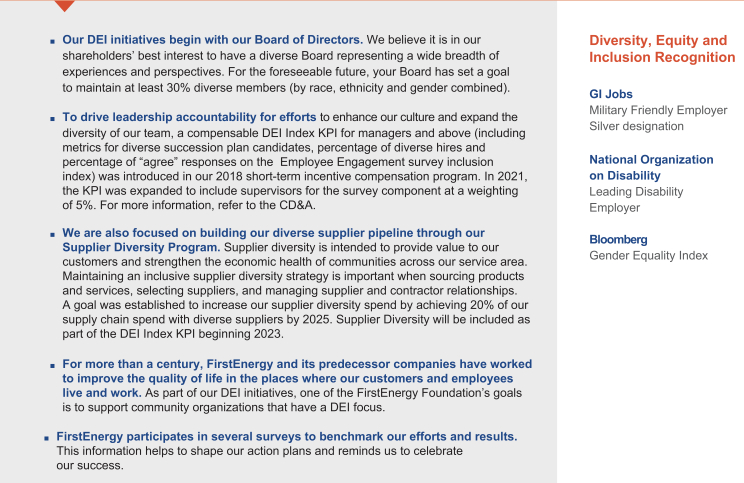
Workforce Pay Equity and Compensation
FirstEnergy’s total rewards program is designed to attract, motivate, retain and reward employees for their role in the success of FirstEnergy. The base pay program is designed to provide individual base pay levels that balance an employee’s value to FirstEnergy with comparable jobs at peer companies. FirstEnergy is committed to ensuring that our internal policies and processes support pay equity, which was confirmed in a third-party review of our practices in 2019 and continues to be part of our normal ongoing process. Our internal processes ensure pay equity considerations are part of our normal ongoing process. The annual incentive compensation program is designed to reward the achievement of near-term corporate and business unit objectives. Additionally, FirstEnergy’s long-term incentive compensation program is designed to reward eligible executives for FirstEnergy’s achievement of longer-term goals intended to drive shareholder value and growth. In addition to base pay and incentive compensation plans, FirstEnergy offers a comprehensive benefits program, including a 401(k) savings plan and a defined benefit pension plan.
Employee Growth and Development
We believe understanding our rapidly changing industry and our Company strategy is key to our employees’ abilities to support our mission and meet our customers’ evolving needs. We are committed to preparing our high-performing workforce for the future and helping employees reach their full potential. We provide employees with opportunities to develop their skills and competencies and prepare our emerging leaders for expanded responsibilities. Our career management process requires that employees put an
| 2023 PROXY STATEMENT | 50 |
Proxy | Corporate | Items to Be | Commitments to EESG | Executive & Director Compensation | Other Important Matters / Q&A |
intentional focus on their development and identify development plans that support their ability to learn and grow in their current roles and to help prepare for future opportunities. We provide tools, programs and resources to support employees in owning their careers and development. As an example, in 2022, we launched a Talent Management Transparency education series to help employees understand our hiring, performance management and succession planning processes in support of their development.
Toward that end, we are actively engaged in the following initiatives:
Talent Management | We have robust processes to support recruiting, career management, succession planning, and employee and leadership development. We focus on transparency, consistency and inclusivity in all of our talent processes. We enhanced our diversity recruiting practices and use labor market availability data to guide our sourcing and recruitment efforts, requiring expanded racial/ethnic diversity on the candidate slates for a broader range of positions. Through our FirstEnergy Ambassador Network, we have increased investment in outreach and support to programs, schools and organizations that provide a pipeline of diverse talent and position FirstEnergy as an employer of choice including $200,000 earmarked to support organizations that focus on racially/ethnically diverse talent. ◾ We have trained over 400 hiring champions and experts across FirstEnergy to participate in diverse interviewing panels and follow a rigorous, behavior-based interview process tied to critical competencies and behaviors that ensures unbiased selection of the best candidate. ◾ This transparency fosters a more robust exchange of information and feedback between employees and leaders and promotes a clearer understanding of career management and development opportunities. Meaningful conversations between leaders and their employees empower employees to take ownership of their careers, build trust, and lead to a more inclusive workplace. ◾ We demonstrated continued agility by successfully facilitating our leadership training programs, talent reviews, recruiting, co-op/intern program and onboarding processes in virtual formats supporting our continued commitment to a more flexible and inclusive work environment. | |||
Mentoring Program | We expanded our mentoring program, which is available to all non-physical workers, by encouraging all high performing, high potential racially/ethnically diverse talent to participate in support of their ongoing development. ◾ This program provides the ability for employees to select a mentor from across the organization. It enhances learning, teamwork and collaboration throughout FirstEnergy, cultivates an environment for professional growth and encourages leaders to guide and prepare colleagues. ◾ Our mentoring program supports the development and retention of employees, increases job satisfaction for mentees and mentors, and facilitates skill and knowledge-sharing across the Company. Since its inception, over 500 people have participated in the formal program, and it continues to grow. | |||
| 51 | FIRSTENERGY CORP. |
Proxy | Corporate | Items to Be | Commitments to EESG | Executive & Director Compensation | Other Important Matters / Q&A |
Employee & Leadership Development | We offer multiple leadership and employee development experiences aligned to our core values to build a highly qualified, engaged and diverse leadership pipeline. ◾ Our New Supervisor and Manager Program (“NSM”), designed to provide consistent training and development to new FirstEnergy leaders, graduated 85 participants in 2022. The NSM program has now graduated over 2,400 leaders since its inception in 2008. ◾ The Experienced Leader Program (“ELP”) bridges the development between new supervisors and managers and senior executives by providing development for experienced manager and director-level employees. Through this program, we equip our leadership with the tools to coach and support their teams and ultimately drive FirstEnergy’s long-term success. Since launching ELP in 2020, we have completed three cohort-based programs with more than 75 participants. ◾ In 2022, we launched the inaugural offering of the Aspiring Leader Program tailored for top talent, individual contributors who are ready near-term for a leadership role. This virtual program provides interactive, cohort-based learning sessions on fundamental leadership development topics to prepare participants for a future leadership role. ◾ The Educate to Elevate program provides a pathway to secondary education for employees seeking a 2-or 4-year college degree and is now operational across the FirstEnergy footprint. For the Fall 2022 semester, 46 employees are enrolled to pursue an associate and/or bachelor’s degree. ◾ External partnership with the Center for Creative Leadership® and BeingFirst® for senior and executive leadership development. | |||
Workforce Development | We are piloting different apprenticeship models for lineworker and substation electrician positions that will strengthen FirstEnergy’s competitive edge in obtaining high-quality employees. ◾ We continue to identify opportunities to establish community partnerships, which help us recruit a more diverse candidate pool in support of FirstEnergy’s value of Diversity, Equity, and Inclusion. As these partnerships mature both the organizations and FirstEnergy will be able to meet mutually beneficial objectives that serve the greater community. | |||
Climate Strategy and Oversight
At a high level, our Climate Strategy consists of two major efforts: reducing GHG emissions and enabling the energy transition to a low-carbon future.
Importantly, our Climate Strategy is a key component of our company strategy. That alignment means efforts to implement and execute our Climate Strategy also support and advance our company strategy. Additionally, it means FirstEnergy is well-positioned to strategically consider climate-related risks and capitalize on opportunities that emerge in the energy transition.
Reducing GHG Emissions to Achieve Carbon Neutrality by 2050 | Enabling the Energy Transition to a Low-Carbon Future | |
| Transitioning away from our two regulated coal plants by 2050 | Protecting and enhancing the transmission system to support grid reliability and enable increased renewables and other clean energy trends | |
| Reducing SF6 emissions from transmission equipment | Building the technologically advanced distribution grid of the future by implementing grid management solutions, smart meters, automation, EV charging infrastructure and other emerging technologies | |
| Electrifying our vehicle fleet | Being innovative and forward-thinking with our coal generation fleet as we explore opportunities to incorporate renewable resources and implement emerging technologies | |
| 2023 PROXY STATEMENT | 52 |
Proxy | Corporate | Items to Be | Commitments to EESG | Executive & Director Compensation | Other Important Matters / Q&A |
Climate Strategy Oversight
FirstEnergy’s Board of Directors provides oversight and guidance on EESG topics, including climate change. The Board has five standing committees that, through their respective oversight responsibilities, assist in guiding FirstEnergy’s Climate Strategy and related efforts. The Corporate Governance, Corporate Responsibility and Political Oversight Committee has general responsibility for oversight of EESG matters and receives climate-related updates at its meetings. In coordination with the Corporate Governance, Corporate Responsibility and Political Oversight Committee, the Operations and Safety Oversight Committee reviews and monitors environmental-related strategies, initiatives and policies, including in the area of climate change. The Finance, Audit and Compensation Committees also provide specific oversight of EESG matters that fall within the scope of responsibilities set forth in each of their charters. Please see the company’s Climate Report for additional climate-related board oversight information: https://fecorporateresponsibility.com/content/dam/investor/files/climate-report.pdf.
At the management level, responsibilities for climate matters are spread across the company’s five organizational pillars – Finance & Strategy, Customer, Operations, Legal, and Human Resources & Corporate Services. Cross-functional management-level committees – including the Corporate Responsibility Steering Committee and its Climate Subcommittee – are designed to bring relevant leaders together to help ensure FirstEnergy is advancing climate action in alignment with our corporate strategy, identifying and managing climate risks, capitalizing on energy transition opportunities, and providing transparency through disclosure efforts. Visit our Climate Report for more information on these management-level committees: https://fecorporateresponsibility.com/content/dam/investor/files/climate-report.pdf .
Climate Risk Oversight
The full Board provides oversight of risk management practices, reviews material company risks – including the climate-related ones – and helps ensure processes are in place to support a strong risk management culture. In addition, the Board’s Audit Committee oversees the Enterprise Risk Management (ERM) program and process for identifying, assessing, managing and monitoring enterprise risks; ensures risks are appropriately communicated with the Board and its committees; oversees enterprise risks and corresponding control and mitigation steps related to the committee’s specific responsibilities; and annually reviews the risk management governance, guidelines, policies and procedures.
At the management level, the head of our risk management group provides executive-level oversight of day-to-day risk management efforts and prepares enterprise-wide risk management reports for presentation to the Audit Committee and the full Board. In addition, a management-level Enterprise Risk Management Committee provides oversight and monitoring to help ensure that appropriate risk policies and management processes are established and executed.
Climate risks are integrated into our ERM process much like any other enterprise risk. FirstEnergy’s current material climate risks are identified and discussed in our Annual Report on Form 10-K. To read more about FirstEnergy’s risk management oversight and the ERM program and process, including the integration of climate risks, please see the Corporate Responsibility website and our Climate Report.
Political and Public Policy Engagement
As a utility obligated to provide reliable and affordable power to customers, FirstEnergy has a legitimate stake in public policy outcomes and a responsibility to advocate for public policy issues that impact the company and its stakeholders. We have continued to reshape our approach to political and public policy engagement in the past year, ensuring closer alignment to our strategic goals and core values. This enhanced approach also includes more robust oversight and disclosure of the Company’s advocacy going forward. We engage thoughtfully and responsibly as we advocate for our interests and attempt to effect positive change for the customers and communities we serve. Our Political & Public Engagement Policy guides that principled engagement by providing strong, clear expectations for the Company, its directors, officers, employees and those acting on the Company’s behalf. In addition, in conjunction with the responsibilities of the full Board, the Corporate Governance, Corporate Responsibility and Political Oversight Committee Charter includes robust oversight requirements of the Company’s Political and Lobbying Action Plan.
| 53 | FIRSTENERGY CORP. |
Proxy | Corporate | Items to Be | Commitments to EESG | Executive & Director Compensation | Other Important Matters / Q&A |
Physical Security and Cybersecurity
FirstEnergy is committed to protecting its employees, customers, facilities, and the ongoing reliability of its electric system. We work closely with state and federal agencies and our peers in the electric utility industry to identify physical and cybersecurity risks, exchange information, and put safeguards, including training, in place to comply with strict reliability and security standards. From a security standpoint, the electric utility sector is one of the most regulated industries. We have comprehensive cyber and physical security plans in place, but we do not publicly disclose details about these measures that could aid those who want to harm our customers, our employees, or our assets.
Your Board has identified cybersecurity as a key enterprise risk and prioritizes the mitigation of this risk. Your Board receives cybersecurity updates at each of its regularly scheduled meetings. The Operations and Safety Oversight Committee reviews our cybersecurity risk management practices and performance, primarily through reports provided by management, including the Chief Information Security Officer. The Operations and Safety Oversight Committee also reviews and discusses with management the steps taken to monitor, control, and mitigate such exposure, and oversees audits of the cybersecurity program. Among other things, these reports have focused on incident response management and recent cyber risk and cybersecurity developments.
Both cyber and physical security enhancements are also a key component of FirstEnergy’s Energizing the Future transmission investment program. The Company invests heavily in sophisticated and layered security measures that use both technology and physical barriers to protect critical transmission facilities and our digital communications networks. In 2022, your Company did not experience any material breaches due to cybersecurity threats.
Unrelenting Customer Focus
We recognize that our more than 6 million utility customers depend on us to provide the reliable energy they need every day of the year. One of the ways we hold ourselves accountable for service reliability is by including metrics – distribution System Average Interruption Duration Index (SAIDI) and Transmission Outage Frequency (TOF) –in our key performance indicators (KPIs). We also set longer-term goals to drive improvement. We are targeting a 20% reduction in transmission outage frequency on 100 kV-and-above lines by 2025, compared to our 2019 baseline. On the distribution side, we’re targeting a 5%, or nine-minute, reduction in the duration of service interruptions by 2025, compared to our 2019 baseline.
We are building a culture with FE Forward that helps us to maintain a strategic and unrelenting focus on our customers. Through FE Forward, we are putting the customer experience at the center of all we do and developing and implementing improvements designed to create a more modernized and effortless customer experience. This includes delivering a superior customer experience today, anticipating customer expectations, and getting ahead of market demands in the future.
Community Vitality
The FirstEnergy Foundation invests in nonprofit organizations to enable positive, sustainable changes that strengthen the communities we serve. The Foundation’s priorities range from supporting key safety initiatives and promoting workforce and economic development to improving social and cultural aspects of our region. As an overarching priority in line with our companywide focus on DEI, the Foundation also supports organizations and initiatives that serve diverse populations and enhance inclusion.
Our corporate giving strategy also focuses on initiatives that parallel our business interests, while helping our communities and the people who live in them achieve greater success. Whether directed to the United Way or local foodbanks, our corporate contributions and philanthropic outreach support organizations and projects dedicated to improving the environmental, economic, social, educational and cultural aspects of our communities.
We are also committed to supporting employee volunteerism through a robust Employee Volunteer Program and the long-term economic health of the communities we serve through development initiatives that create jobs, support local suppliers and attract new businesses throughout our service area.
| 2023 PROXY STATEMENT | 54 |
Proxy | Corporate | Items to Be | Commitments to EESG | Executive & Director Compensation | Other Important Matters / Q&A |
EESG Oversight and Management
Board and executive-level oversight of these EESG topics and other governance topics discussed throughout this Proxy Statement is vital to our commitment to corporate responsibility and our Company’s success.
FirstEnergy’s Board committees each provide oversight and guidance on distinct employee, environmental, social and governance related topics. For a breakdown of their EESG oversight responsibilities, please review the committee charters (www.firstenergycorp.com/charters) and visit the Board Governance page of our Corporate Responsibility website (www.fecorporateresponsibility.com). In addition to these EESG oversight roles and responsibilities, our Corporate Responsibility Department, senior leadership-level Corporate Responsibility Steering Committee, management-level Climate Subcommittee, and Corporate Governance, Corporate Responsibility and Political Oversight Committee of the Board work to ensure the transparency and accountability of FirstEnergy’s EESG efforts and continuously strive to improve our EESG performance across the Company.
EESG Accountability and Transparency
FirstEnergy is committed to providing stakeholders with information about our corporate responsibility approach and EESG initiatives and performance. As part of our commitment to transparency and accountability, we have a dedicated Corporate Responsibility website, which details FirstEnergy’s progress on EESG-related topics. Information on our website, including with respect to our corporate responsibility and EESG initiatives and performance, does not constitute part of (and shall not be deemed incorporated by reference into) this Proxy Statement or any other document we file with the SEC. We also are working toward disclosing EESG information in alignment with leading sustainability reporting frameworks, including the Sustainability Accounting Standards Board, Taskforce on Climate-Related Financial Disclosures, Global Reporting Initiative and Edison Electric Institute ESG/Sustainability Template.
Setting goals and disclosing our progress are also critical parts of demonstrating transparency and accountability on EESG matters. Our companywide goals, available on our Corporate Responsibility website, are designed to prepare us to meet our customers’ future energy needs and move us closer to our vision for a more resilient, innovative, diverse and sustainable FirstEnergy.
In addition, our annual key performance indicators (KPIs) that make up our Short-Term Incentive Program for employees also have strong ties to EESG. Our KPIs measure performance and improvement in areas that are high priorities for the Company and critical to our continued success. Among others, those areas include customer reliability, customer service, environmental protections, safety and diversity, equity and inclusion. These incentive-based KPIs support our commitment to strong EESG performance.
| 55 | FIRSTENERGY CORP. |
Proxy | Corporate | Items to Be | Commitments to EESG | Executive & Director Compensation | Other Important Matters / Q&A |
Executive Compensation
Compensation Committee Report
The Compensation Committee reviewed and discussed the Compensation Discussion and Analysis (“CD&A”)&A with management and based on such review and discussions, the Compensation Committee recommended to your Board that the CD&A be included (or incorporated by reference, as applicable) in the Company’s Annual Report on Form 10-K for the fiscal year ended December 31, 2020,2022, and this 2021 Proxy Statement.
Compensation Committee: James F. O’Neil III (Chair), Sandra Pianalto,Steven Demetriou, Lisa Hicks, Paul Kaleta, and Leslie M. Turner.Sean Klimczak.
Compensation Discussion and Analysis
Introduction
This CD&A provides an overview of the Company’s strategy and performance, shareholder engagement process, 20202022 executive compensation programs and decisions, and initial planscurrent expectations for the 20212023 executive compensation programs. This CD&A focuses on the compensation of our NEOs, who are as follows, for fiscal year 2020:2022:
| Named Executive Officer | Current Title | |
| Chair of the Board and Interim President and | |
K. Jon Taylor | Senior Vice President, | |
Samuel L. Belcher | Senior Vice President, | |
| Senior Vice President, | |
Christine L. Walker | Senior Vice President, | |
| Former | |
| ||
Key Executive Officer Transitions and Appointments
On October 29, 2020, Mr. Strah became Acting CEO in addition to servingSomerhalder has served as the President of the Company, a position to which he was promoted in May 2020 after previously serving as Senior Vice President and CFO of the Company since March 2018. Mr. Strah’s appointment to Acting CEO followed the determination by the Independent Review CommitteeChair of the Board of Directors (“Independent Review Committee”)since May 2022 and had previously served as Vice Chair and Executive Director from March 2021 to terminate Mr. Jones as the Company’s Chief Executive Officer effective October 29, 2020. These actions by the Independent Review Committee follow the Company’s internal review related to the ongoing government investigations, the existence of which was previously disclosed in the Company’s Form 10-Q for the period ended June 30, 2020. As a result of Mr. Jones’ termination, and due to the determination that Mr. Jones violated certain Company policies and its code of conduct, all grants, awards and compensation under the Company’s short-term incentive compensation program and long-term incentive compensation program with respect to Mr. Jones that were outstanding on the date of termination have been forfeited.May 2022. On March 7, 2021,September 15, 2022, the Board appointed Mr. Somerhalder to serve as Interim President and CEO, effective as of September 16, 2022, while continuing to serve in his role as Chair of the Board. Mr. Somerhalder’s appointment followed the decision of Mr. Strah to retire as the President and CEO. On March 22, 2023, the Board appointed Mr. Tierney to the position of CEOPresident and Chief Executive Officer of FirstEnergy, effective as of March 8, 2021. The Board also electedJune 1, 2023. Mr. Strah as a Director of the Company, effective as of March 8, 2021.
In May 2020, Mr. Taylor became Senior Vice President and CFO after previouslySomerhalder will cease serving as Vice President, Utility Operations since April 2019. Mr. Reffner was appointed to the position of Senior ViceInterim President and Chief LegalExecutive Officer inon May 2020 after serving31, 2023, but will continue to serve as Senior Vicea non-employee director on your Board. Mr. Tierney is not an NEO for purposes of this Proxy Statement due to the fact that he will not commence service with us as President and General Counsel sinceChief Executive Officer until June 1, 2023.
The table below details Mr. Somerhalder’s different roles throughout 2022 as well as the target total compensation (on an annualized basis) and realized compensation of each role:
Title | Dates Served During 2022 | 2022 Annualized Base Salary | 2022 Target Opportunity STIP (% of Base Salary) | 2022 Target Opportunity LTIP Awards (% of Base Salary) | 2022 Other Equity Opportunity (% of Base Salary)(2) | Annual Retainer and Chairman Fee | 2022 Target Total Compensation | 2022 Realized Compensation(3) | ||||||||||||||||||||||
Vice Chair and Executive Director | 1/1-5/20 | $ | 750,000 |
|
| 100 | % |
| N/A |
|
| 334 | % |
| N/A |
| $ | 4,005,000 |
| $ | 2,185,759 |
| ||||||||
Chair of the Board(1) | 5/21-9/15 |
| N/A |
|
| N/A |
|
| N/A |
|
| N/A |
| $ | 512,500 |
| $ | 512,500 |
| $ | 166,002 |
| ||||||||
Interim President and CEO | 9/16-12/31 | $ | 1,250,000 |
|
| 125 | % |
| N/A |
|
| 576 | % |
| N/A |
| $ | 10,012,500 |
| $ | 758,970 |
| ||||||||
(1) Following Mr. Somerhalder’s appointment as non-independent Chair of the Board, the Board approved compensation of an additional $250,000 retainer ($150,000 in cash and $100,000 in equity) for Mr. Somerhalder’s service as Chair of the Board, effective May 21, 2022, in addition to the $250,000 ($275,000, effective July 1, 2022)
| 2023 PROXY STATEMENT | 56 |
Proxy | Corporate | Items to Be | Commitments to EESG | Executive & Director Compensation | Other Important Matters / Q&A |
annual retainer payable under our standard fee structure for non-employee directors. Mr. Somerhalder continued to serve as Chair of the Board after September 2018. On November 8, 2020,16, 2022; however, he is no longer entitled to compensation for the role of non-independent Chair of the Board for the period he serves as Interim President and CEO. See the “Director Compensation in Fiscal Year 2022” section for more details.
(2) For more information on Mr. Reffner was separated fromSomerhalder’s 2022 Other Equity Opportunity, refer to the Company.“Performance-based and Time-based Equity Award for Mr. Somerhalder” section.
(3) For more information on how we calculate Realized Compensation, and for details about the 2022 Realized Compensation of our other NEOs, refer to the “Realized Compensation” section.
Upon Mr. Strah’s retirement, Mr. Strah’s outstanding incentive awards were prorated according to their original terms, and he did not receive severance benefits or accelerated vesting of any incentive awards, or any enhanced compensation. Mr. Strah commenced his qualified pension subject to the early retirement reduced benefit. Upon his retirement and per Company policy for all employees, Mr. Strah received a payout of his banked and frozen vacation earned prior to 2008 and based on the effective pay rate as of December 31, 2008, when FirstEnergy’s vacation policies were revised, and employees and executives could no longer accumulate banked vacation. For more information, refer to the Departed NEO section.
Additional Information
This CD&A uses certain capitalized terms, which are defined in the Glossary of Terms, beginning on page 53.82. In general, we use the term “CEO” in this CD&A to refer generally speaking, to the individual serving as our Chief Executive Officer from time to time, includingOfficer. For 2022, that included Mr. Strah in his role as ActingPresident and CEO through September 16, 2022, and Mr. Somerhalder in his role as Interim President and CEO beginning October 29, 2020.September 16, 2022. In addition, certain of the performance incentive metrics discussed and utilized in
26 | FirstEnergy Corp. 2021 Proxy Statement

measuring pay-for-performance are based on non-GAAP figures, and the definitions for those metrics in the Glossary of Terms explain the calculation methodology to the closest GAAP measure. The Compensation Committee believes that using such non-GAAP metrics best aligns NEO incentive opportunity with Company performance, which directly supports long-term shareholder value. Use of such non-GAAP metrics are helpful to understand and evaluate performance trends when assessing pay-for-performance and are aligned with key aspects of the Company’s financial performance disclosures.
| 57 | FIRSTENERGY CORP. |
Proxy | Corporate | Items to Be | Commitments to EESG | Executive & Director Compensation | Other Important Matters / Q&A |
CD&A Quick Reference Guide
| |||||||
| Key Sections | Core Topics | Page | |||||
| Executive Summary |
| ||||||
Governance of Our Executive Compensation Programs |
| ||||||
Components of Total Direct Compensation Programs |
◾ Incentive Compensation Payouts for
◾ Award Vesting for Ms. Walker ◾ Outstanding Award Cycles
| ||||||
Other Compensation Policies and Practices |
| ||||||
| CD&A Glossary of Terms |
| 82 | |||||
| 2023 PROXY STATEMENT | 58 |
Proxy | Corporate | Items to Be | Commitments to EESG | Executive & Director Compensation | Other Important Matters / Q&A |
27 | FirstEnergy Corp. 2021 Proxy Statement

Moving Forward
Your Board and the management team have acted with a sense of urgency to move your Company forward by taking the steps necessary to address current challenges, improve our compliance culture, and position FirstEnergy for long-term stability and success. As part of this, we are committed to strengthening every part of FirstEnergy’s business and taking the necessary steps to enhance credibility with our shareholders and other stakeholders, including our regulators and the ratings agencies.
When inappropriate conduct was discovered during the course of the internal investigation, which was led by the Independent Review Committee of the Board and outside counsel, your Board took swift and deliberate action by terminating certain members of senior management, including the chief executive officer, and, shortly thereafter, separating with the chief legal and chief ethics officers. To improve the tone at the top, the Board appointed a new acting chief executive officer, named an independent Board member as executive director and enhanced the role of Board Chair. Furthermore, in 2021, your Company externally hired an SVP and chief legal officer, a vice chairperson and executive director, and recently announced that a chief ethics and compliance officer will join your Company in mid-April. These hires will help embed a stronger culture of compliance, ethics, integrity and accountability at FirstEnergy.
In addition to strengthening the leadership team, a new Compliance Oversight Sub-Committee of our Audit Committee was formed to spearhead the Board’s assessment of FirstEnergy’s compliance program and oversee implementation of potential changes, as appropriate. This effort, led by independent director Leslie Turner, engages with outside expertise for help and best practices. To support engagement with all employees, new compliance ambassadors will be designated throughout the Company, and all non-bargaining employees have been assigned a cascading priority from President and CEO Steven E. Strah that supports our objectives around a culture of integrity, accountability, ethics and compliance. Additionally, in March 2021, the Board approved an ethics and compliance component to the 2021 FE STIP which will serve as a negative modifier at the individual level, with downward adjustment only, to reinforce that acting with ethics and integrity is at the core of how your Company operates. This addition to the incentive compensation program supports the desire for a meaningful culture change and a focus on continuing to evolve our ethics and compliance program.
With the Board’s oversight, senior management has made significant changes to your Company’s approach to governmental affairs engagement and is limiting participation in the political process. This also includes ensuring that the disclosures around your Company’s political advocacy are more robust going forward so that it is clear what efforts your Company supports and why they are supported. In March 2021, your Board voted to suspend employee contributions to the FirstEnergy Political Action Committee (FEPAC) made through automatic payroll deduction while the next steps for the FEPAC are evaluated.
We have also taken proactive stepsmade significant progress to resolve a range of regulatory proceedings affectingstrengthen our Ohio utilities. We believe resolving these mattersfinancial profile and revitalize our corporate culture while optimizing our performance through customer-centered investments in a comprehensive manner is a critical step to demonstrateinnovation and technology. These efforts, together with our commitment to transparency and integrity in every aspect of our business, while also enabling FirstEnergy to remove uncertainty relating to current Ohio regulatory matters.
Continued Execution on the Business Plan
In 2020, FirstEnergy displayed strong operational performance, and we successfully executed our regulated growth strategies. Key achievements during the yearstrategy, are positioning FirstEnergy as a premier electric company with sustainable, long-term growth. Recent highlights include:
|
|
|
|
28 | FirstEnergy Corp. 2021 Proxy Statement

|
|
|
|
We continueare on the right path for long-term stability and success as a leading electric company. We intend to strengthenbuild on our transmission and distribution systems through significant investments designed to improve reliability and support our customers’ evolving energy needs. We remain excited about the significant investment opportunities that will help us drive solid earnings and growth in the years ahead.
Looking to the Future
FE Forward
Your Board and executive management team are also implementing key initiatives to enhance shareholder value and reshape FirstEnergy into a more resilient, industry-leading organization of the future. This includes the company-wide FE Forward program that is expected to transform FirstEnergy in a way that provides near-term value while opening new opportunities for longer-term growth.
FE Forward was launched in the fourth quarter of 2020, to support your Company’s future growth trajectory for the benefit of shareholders and all stakeholders. In partnership with McKinsey & Company, employees across our organization are challenging organization traditions, conventional wisdom, and cultural norms. At the same time, we are focused on modernizing our business policies, management practices, processes and technology platforms. This project is expected to deliver substantial operating and capital efficiencies and improve our credit profile, while enabling your Company to reinvest in a truly modern and distinctive experience that improves customer service and satisfaction.
Key opportunities of FE Forward include:
|
|
|
By 2024, FE Forward is projected to generate approximately $300 million in annualized capital expenditure efficiencies while continuing to hold operating expenses flat by absorbing approximately $100 million in projected increases. In addition, your Company expects to generate approximately $250 million in working capital improvements by 2022. This program includes an estimated $150 million of costs to achieve through 2023, which are expected to be self-funded through these efficiencies.
FE Forward is not a downsizing effort and there will not be any involuntary employee reductions in connection with this program. It is expected to be a significant catalyst to augment your Company’s growth potential by taking a more strategic approach to operating expenditures and reinvesting in a more diversified capital program that over the long term continues to support a smarter and cleaner electric grid.
Strategic Goals
We have established new goals for key areas of our business that support our mission to be a forward-thinking electric utility powered by a diverse team of employees committed to making customers’ lives brighter, the environment better and our communities stronger.
29 | FirstEnergy Corp. 2021 Proxy Statement

For example, in November 2020, we published our Climate Strategy, which includes a new comprehensive and ambitious greenhouse gas emission goal. We pledged to achieve carbon neutrality by 2050 and set an interim goal for a 30% reduction in greenhouse gases within your Company’s direct operational control by 2030, based on 2019 levels. In addition, we set a fleet electrification goal beginning in 2021positive momentum as we plan 100% of new purchases forcontinue strengthening our light dutyfoundation, driving a customer-centered focus and aerial truck fleet to be electric or hybrid vehicles, creating a path to electrify 30% of a 3,500-vehicle fleet by 2030 with a goal of complete electrification ofenabling the vehicle fleet by 2050. Also, the Company’s West Virginia utility, Monongahela Power, will seek approval to construct at least 50 MWs) of solar generation.clean energy transition.
To offer additional clarity into our future opportunities and strategies in a rapidly changing industry, we updated our Strategic Plan in January 2021. The plan reinforces our Core Values and Behaviors, which serve as the foundation for how we strive to do business. The Strategic Plan, available online at www.firstenergycorp.com/FEstrategicplan, articulates numerous goals that support our objectives and values, including our carbon neutrality pledge and specific targets related to:
|
|
|
|
|
|
|
|
Shareholder Engagement and Say-on-Pay Results
Our Board and Compensation Committee recognize the seriousness of the events that occurred in 2020 and have taken actions in our 2020 incentive pay programs for members of our senior leadership team, including the continuing NEOs, as further described in the CD&A. Our Board and Compensation Committee are continuing to review the incentive programs in 2021 to appropriately reflect the Company’s needs and continue to drive shareholder value as a result of the experiences in 2020.
Our Board and management are committed to engaging our shareholders and soliciting their perspectives on key performance, compensation and governance issues. Consistent with prior years, select board members and management representatives conducted extensive outreach during 2020.ahead of the filing of this Proxy Statement. Through this outreach, we have not received shareholder concerns regarding the Company’s Say-on-Pay or general executive compensation matters, and the Company continues to design its programs consistent with shareholder feedback.
Our 2020 2022 Say-On-Pay vote successfully passed with about 98%over 95% support, which we consider to be a strong endorsement of our pay practices and is consistent with the vote results in 20192021 of over 96% approval. In 2022, we maintained the same general structure and an increase over the 2018 Say-On-Pay vote of 95%. Accordingly, in 2020, we continued with the design offor our NEO incentive compensation plans and programs and did not make any substantial changes following the 2020 Say-On-Pay voting results.with few modifications. In an effort to align our compensation programs with the interests of shareholders, improve the relationship between pay and performance, better tie our executive compensation programs to our business strategies, and drive the right executive behaviors, the following summary ofwe periodically make incentive design changes were proactively madeadjustments to FirstEnergy’s incentive programs beginningprograms. While the 2022 design and goals of our short-term incentive compensation program has a similar structure to that of prior years, our long-term incentive compensation program for 2022 maintained the Cumulative Operating EPS metric (increasing the weighting from 50% to 65%) while eliminating Average Capital Effectiveness metric and replacing it with awards granted in 2018a standalone Relative TSR metric, weighted at 35%. This design change simplifies the structure of the plan, enhances the link to shareholder value and continuing for awards in 2019 and 2020.is similar to the approach used by our utility peer companies.
| 59 | FIRSTENERGY CORP. |
30 | FirstEnergy Corp. 2021 Proxy Statement





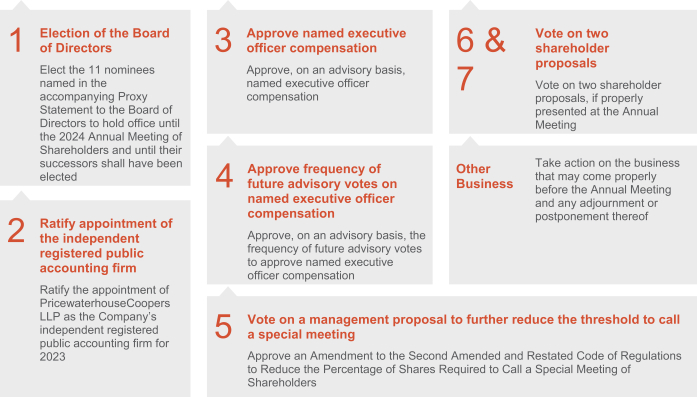














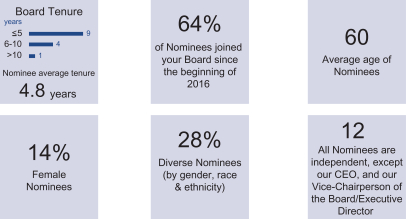

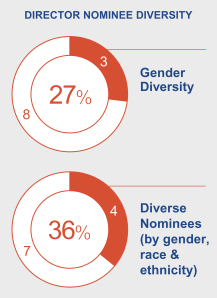











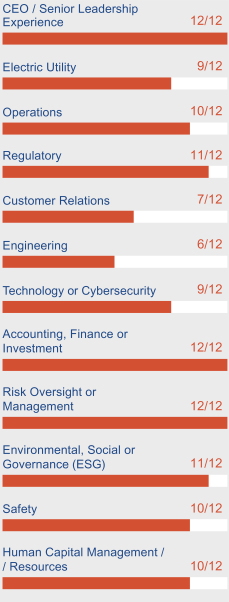

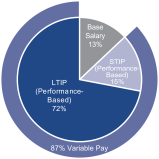
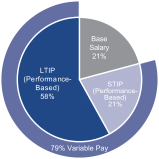





 No executive hedging or pledging is permitted
No executive hedging or pledging is permitted